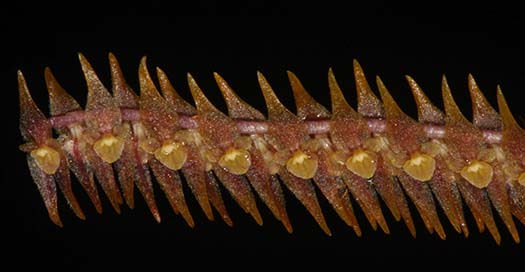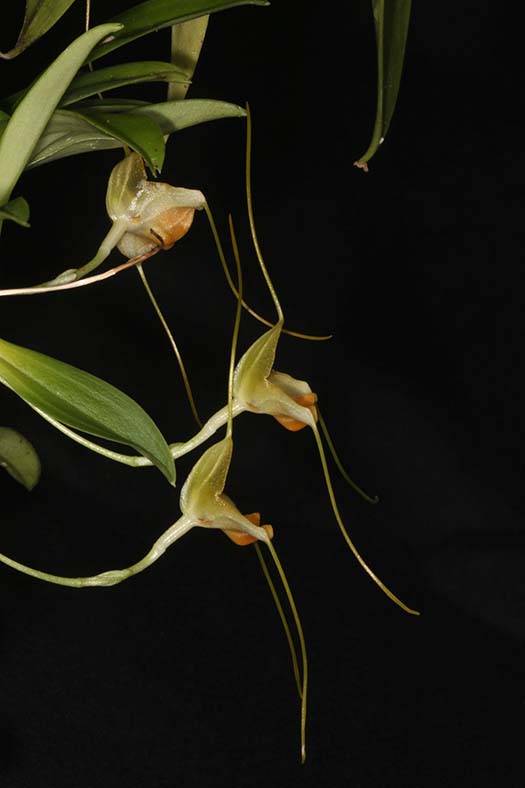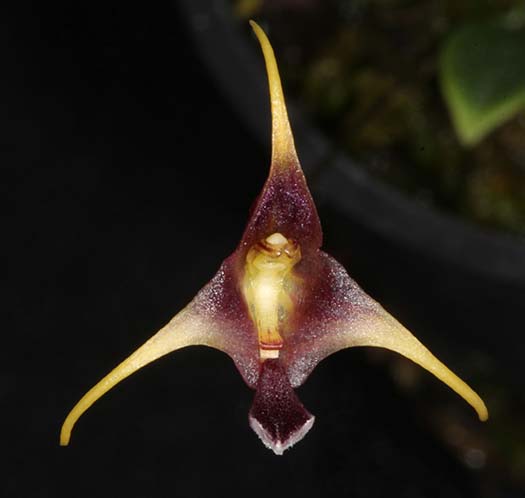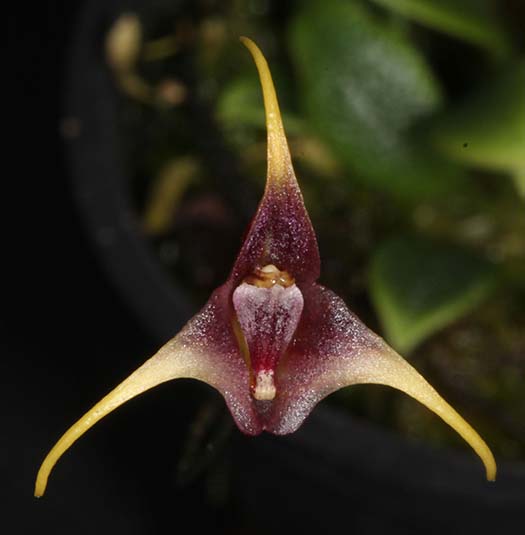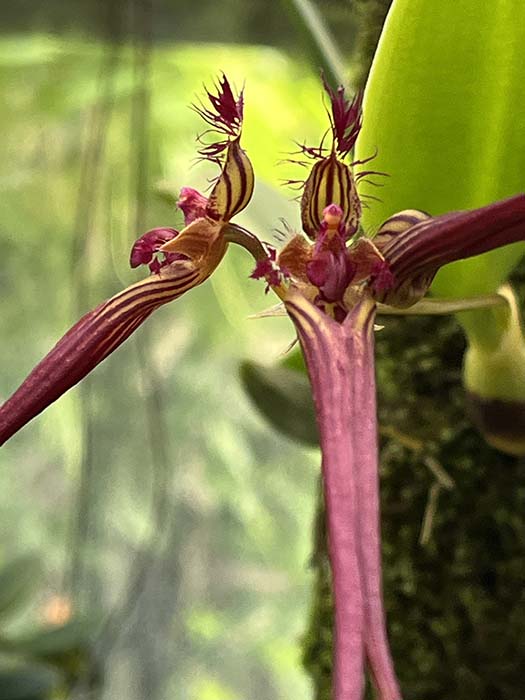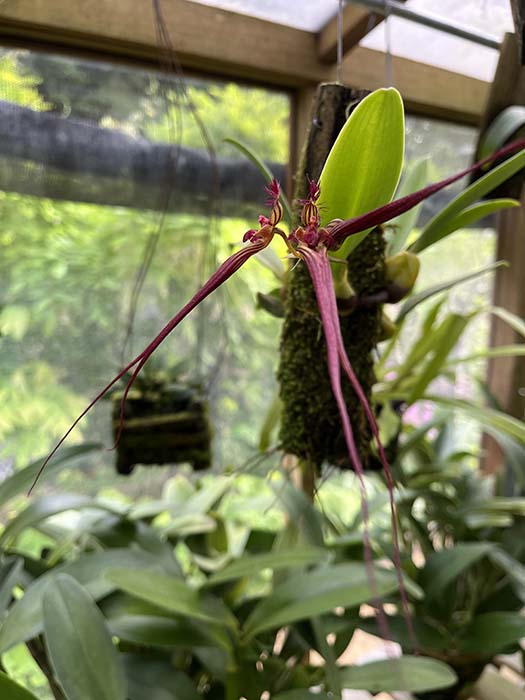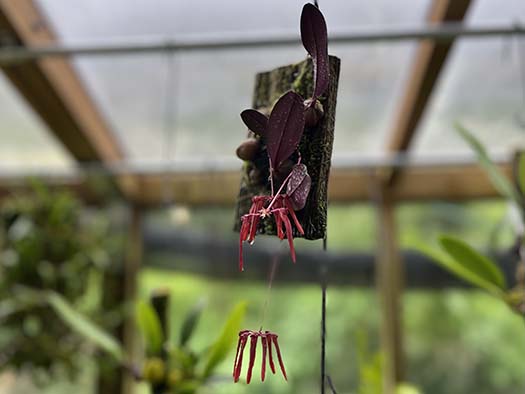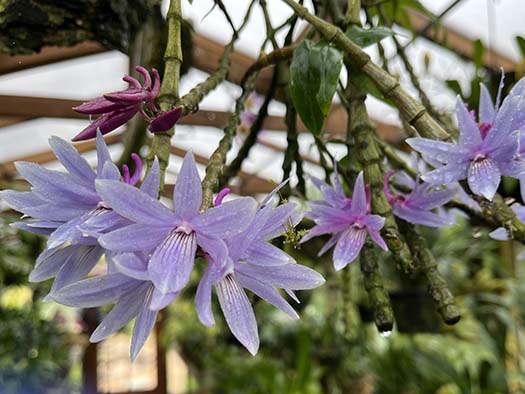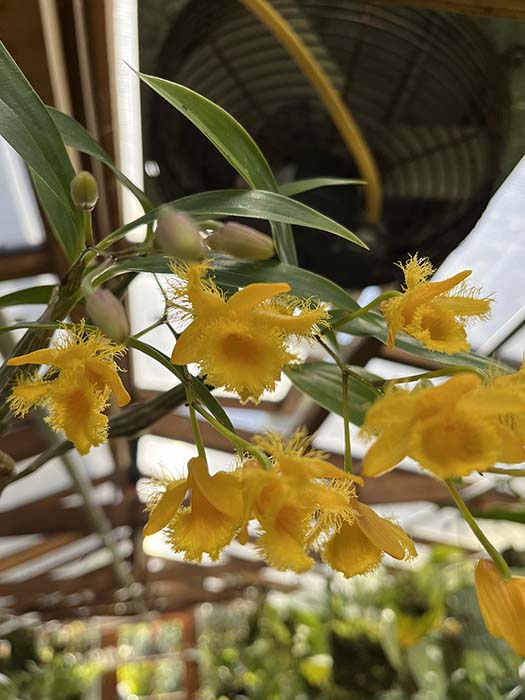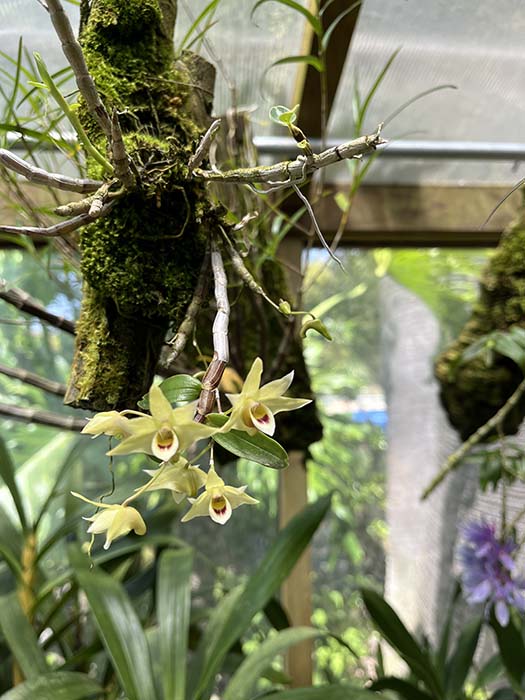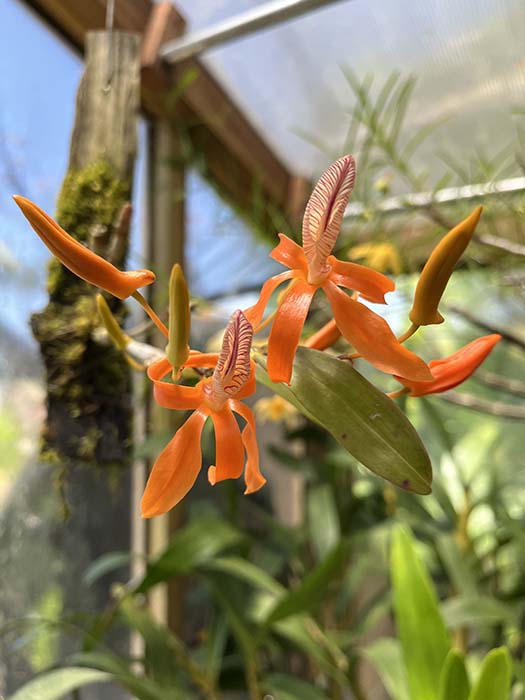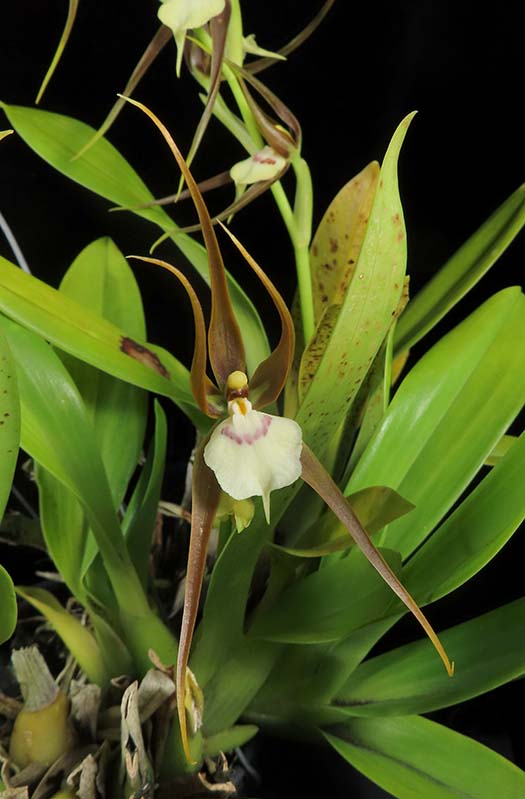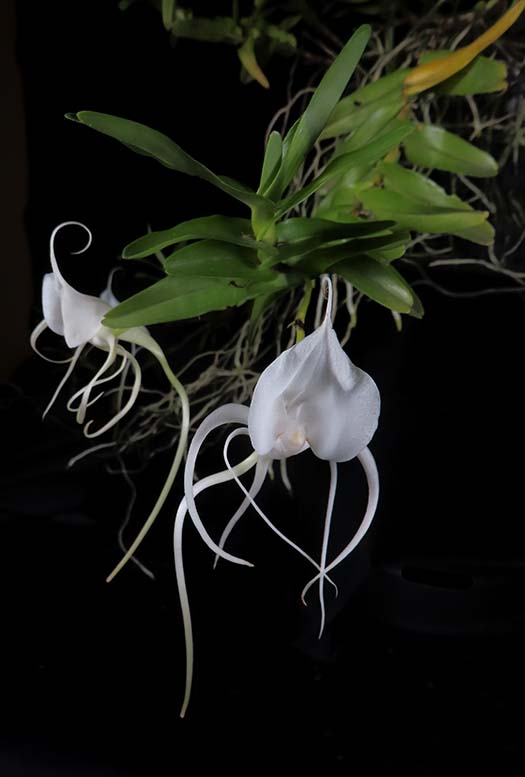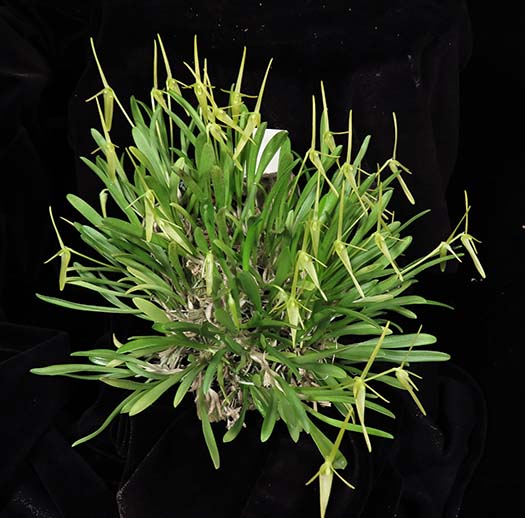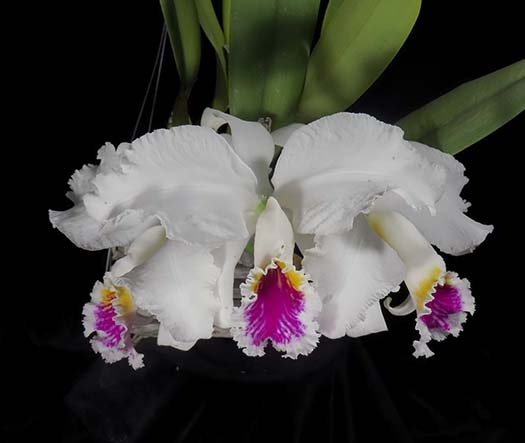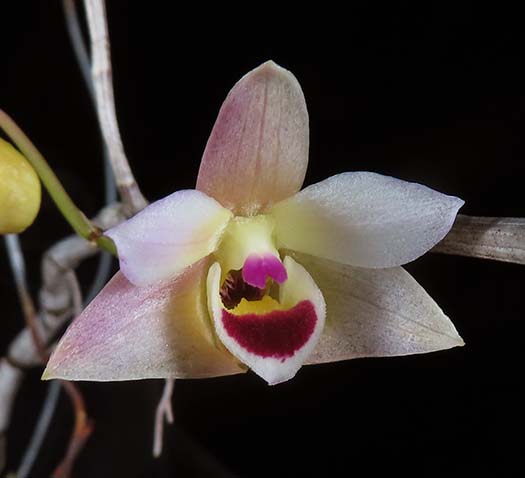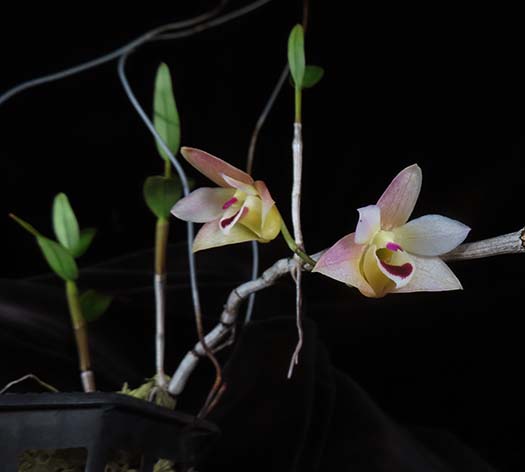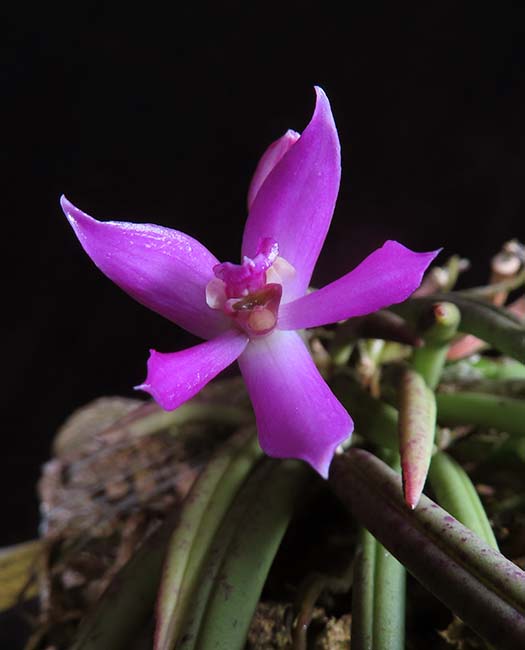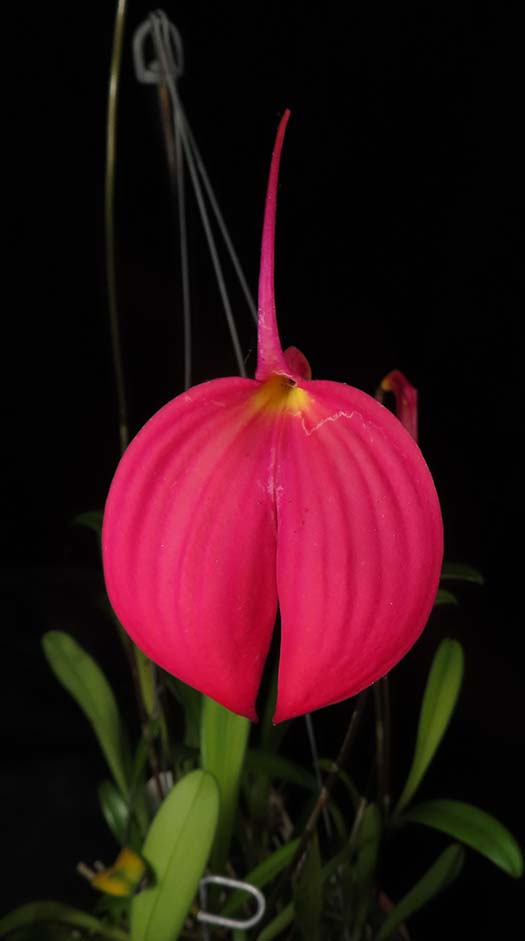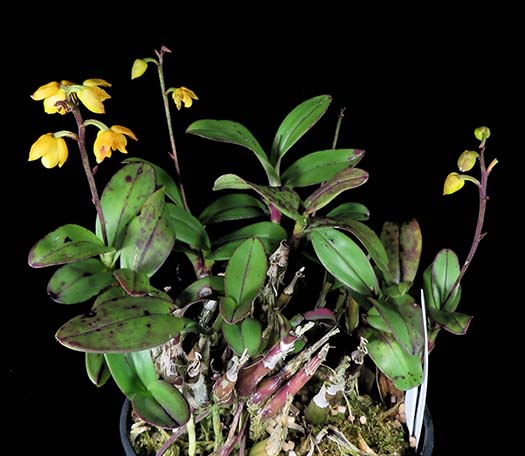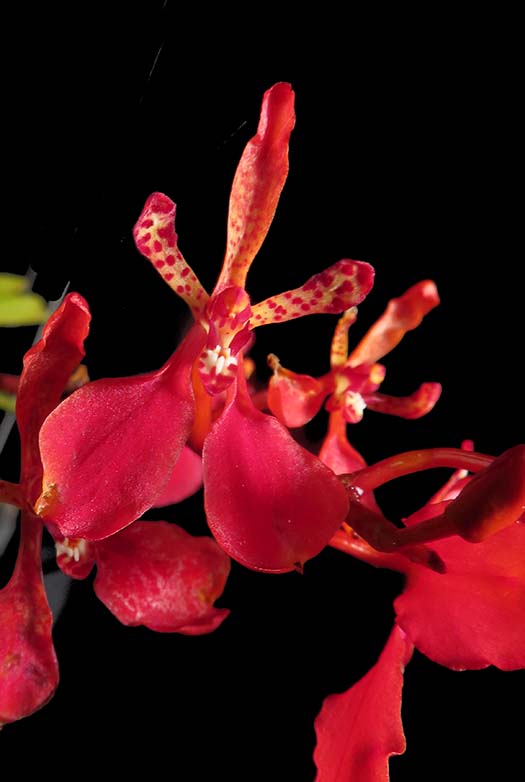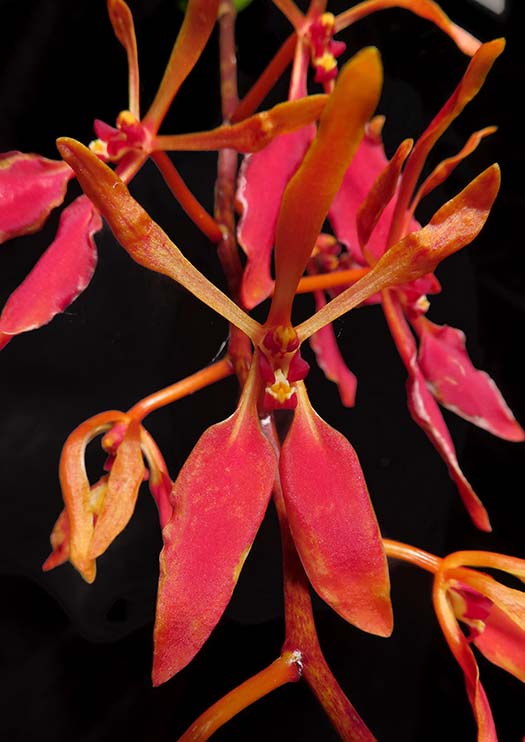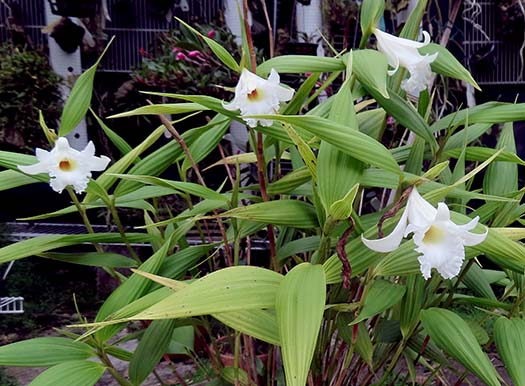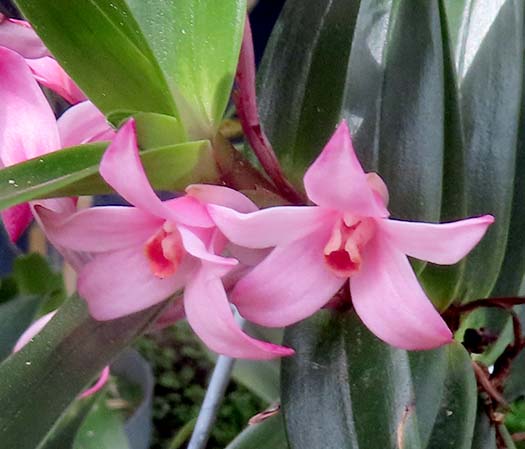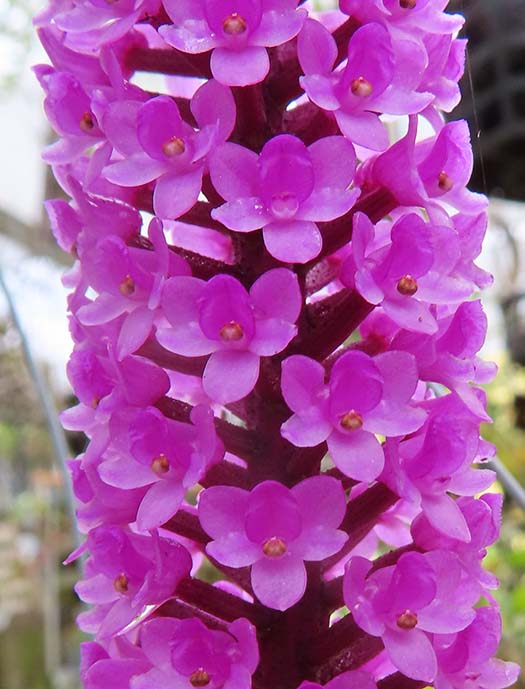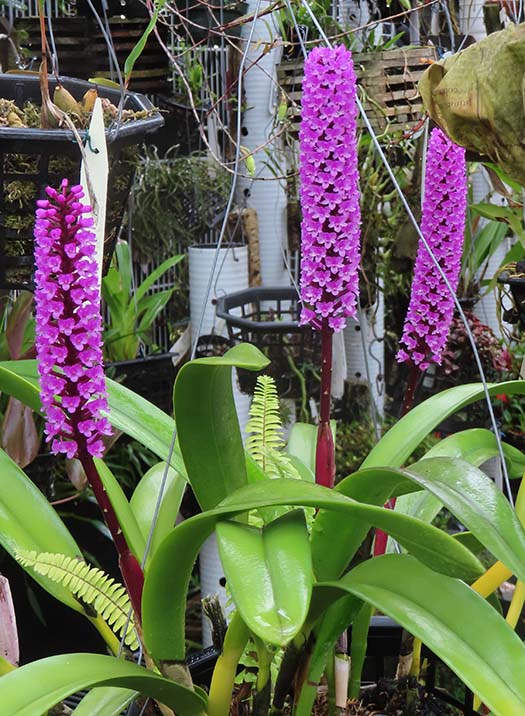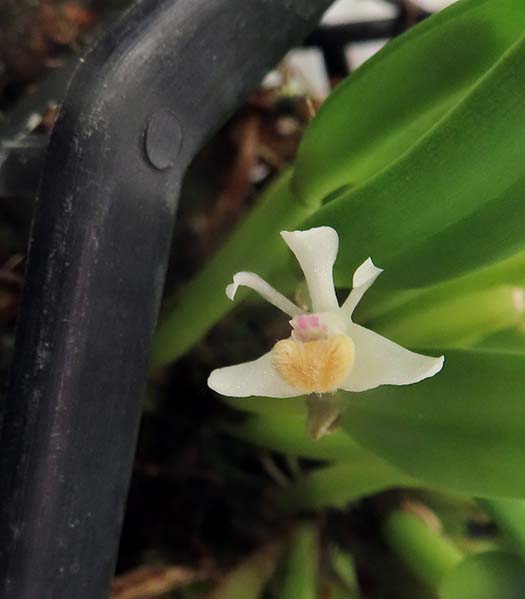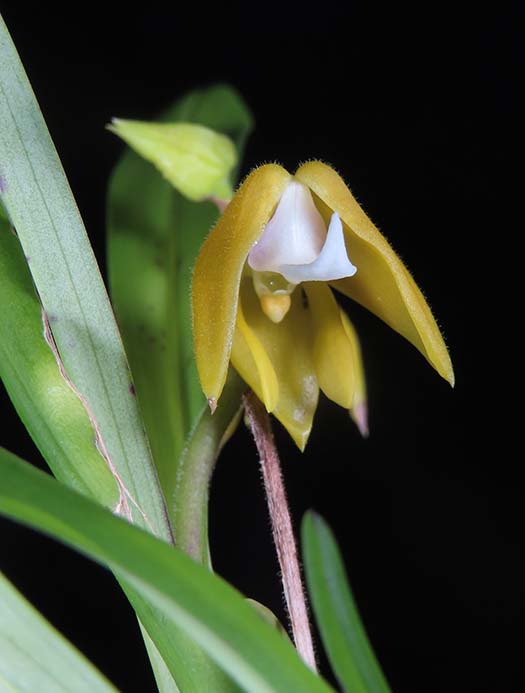June 2024
From Kurt Shanebeck:
|
|
Outdoors coastal, north of Los Angeles: |
|
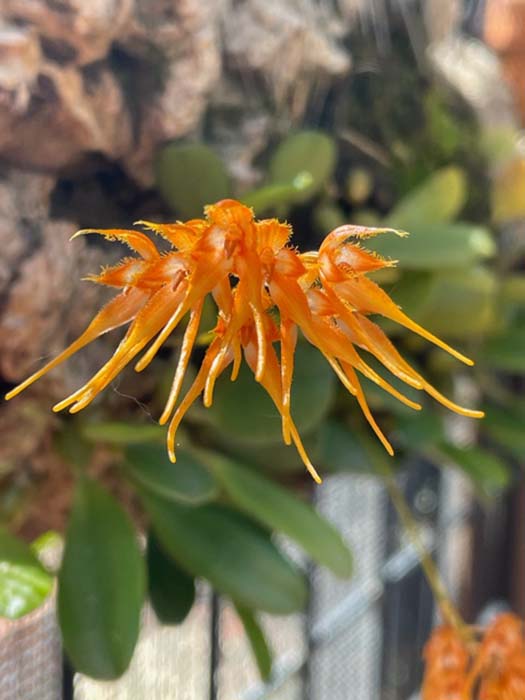
Bulbophyllum taiwanense
|
|
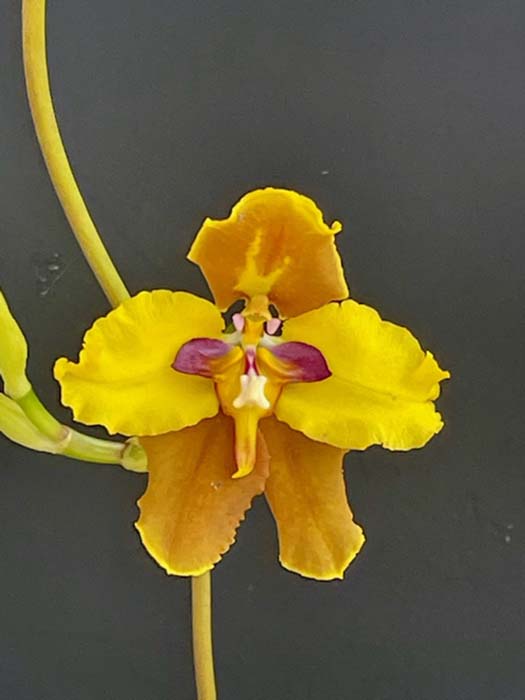
Cyrtochilum macranthumEpiphyte native to Columbia, Peru and Ecuador. Has a very long pendant inflorescence (up to 12’). Growing potted with bright light. |
|

Dendrobium tetragonum v. giganteumEpiphyte native to Australia at elevations of 500-1200m. Growing mounted with moderately bright light. |

Dendrobium williamsoniiEpiphyte native to India, China and Southeast Asia found at elevations of 600-1400m. Growing mounted with bright light. |
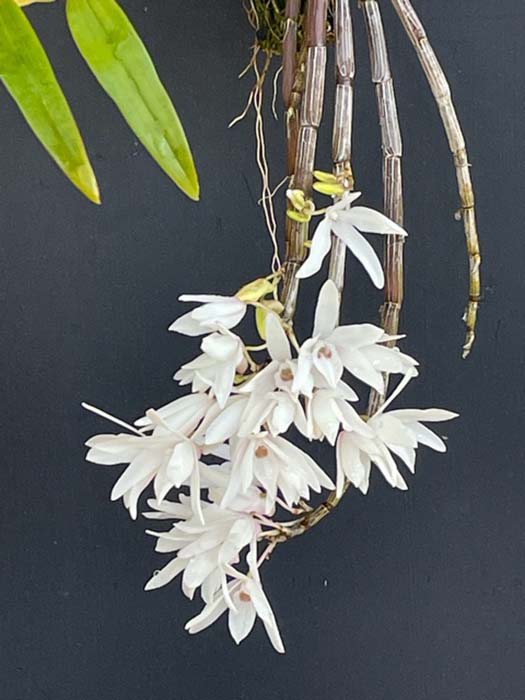
Dendrobium wilsoniiNative to Southern China at elevations of 1000-1300m. Deciduous. Growing mounted with bright light. |
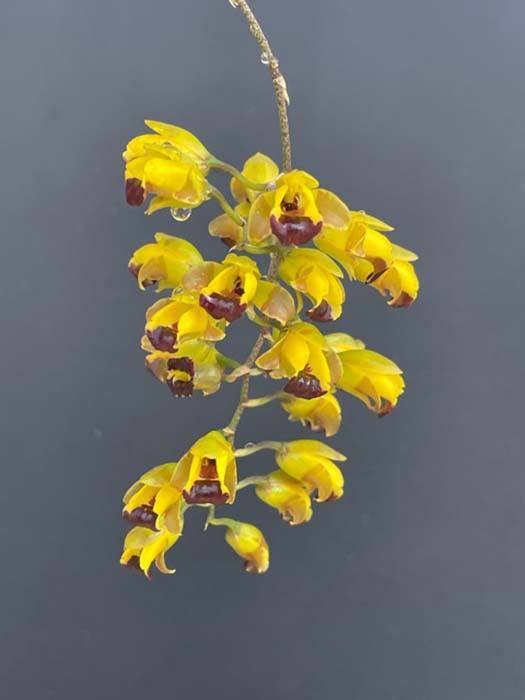
Gomesa echinata (Baptistonia echinata)Epiphyte from Brazil. Pendant inflorescence is reminiscent of a swarm of bees. Growing potted with bright light. |
 |
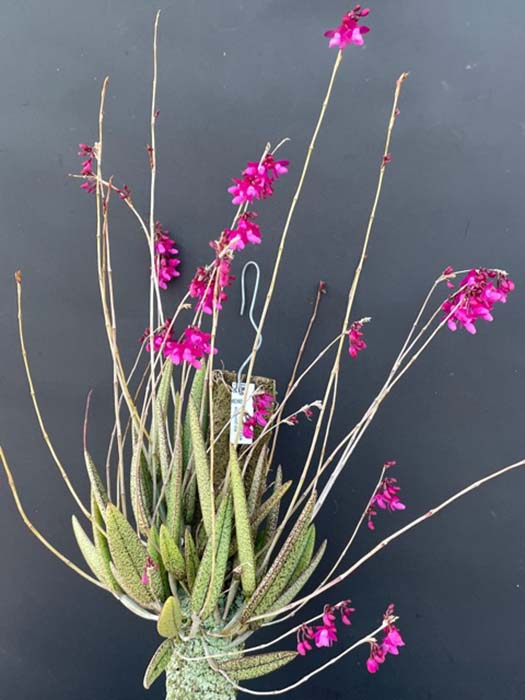 |
Domingoa gemma (Nageliella angustifolia)Native to Mexico and Central America at elevations to 2100m. Has succulent spotted leaves that are very attractive even when plant is not in bloom. Reblooms on old inflorescences. |
|
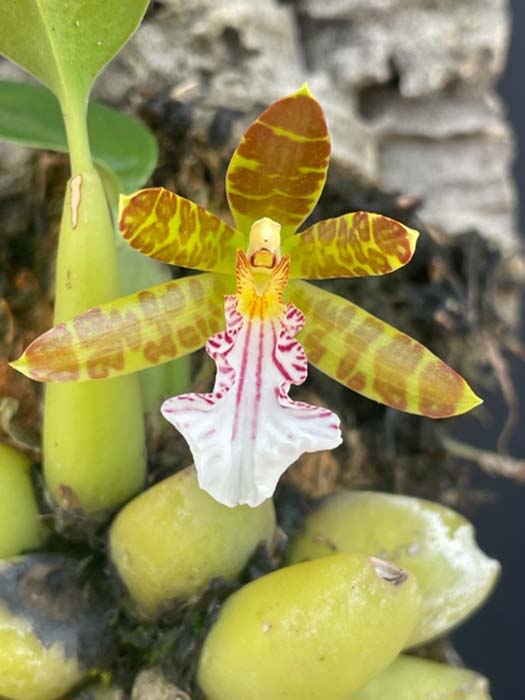
Helcia sanguinolentaEpiphyte from Ecuador, Columbia and Peru at elevations of 600-3000m. Growing mounted, shady and moist. |
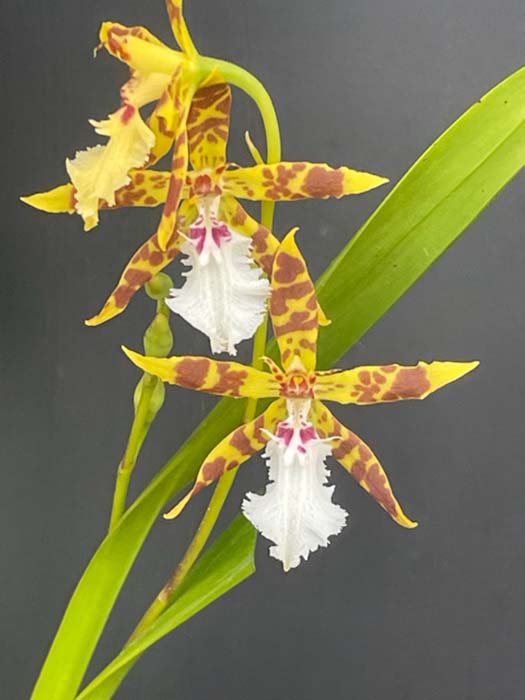
Oncidium aspidorhinumEpiphyte native to Ecuador found at elevations of 2000-2800m. Growing mounted with bright light. |
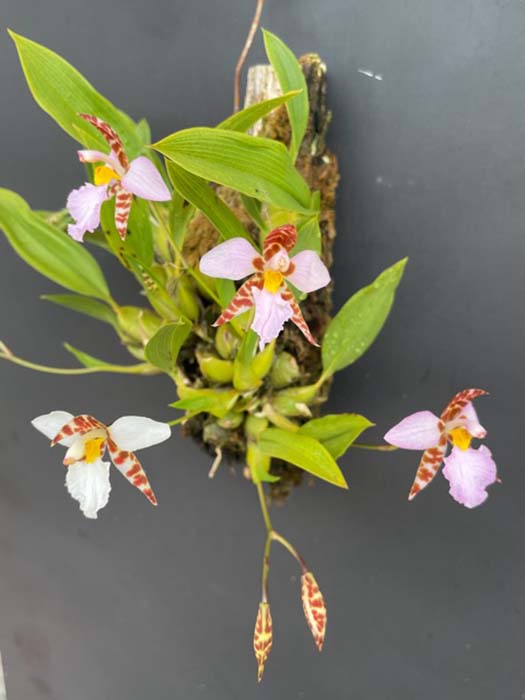 |
Rhynchostele ehrenbergiiEpiphyte native to Mexico. Growing mounted with bright light. I have noticed that the lip and petals are white when the flowers first open but fade to pink after a couple of days. |
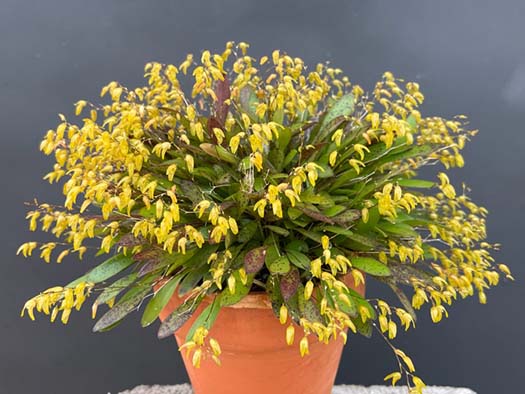
Specklinia grobyiNative to Central America through northern South America. Easy growing compact plant with profuse flush blooming. Growing potted with bright light. |
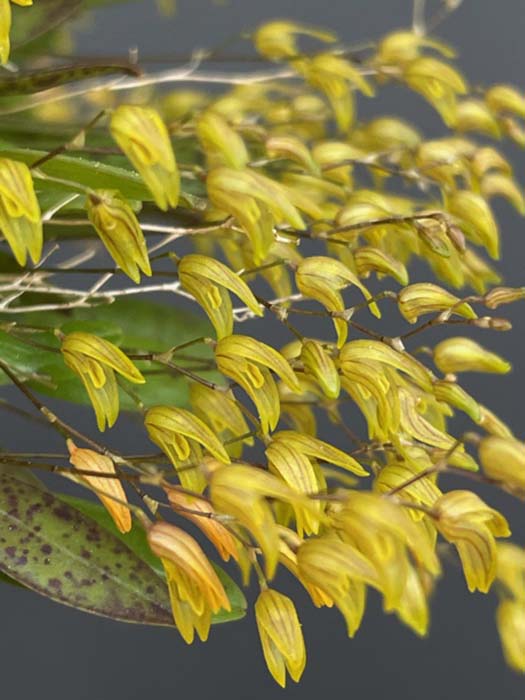 |
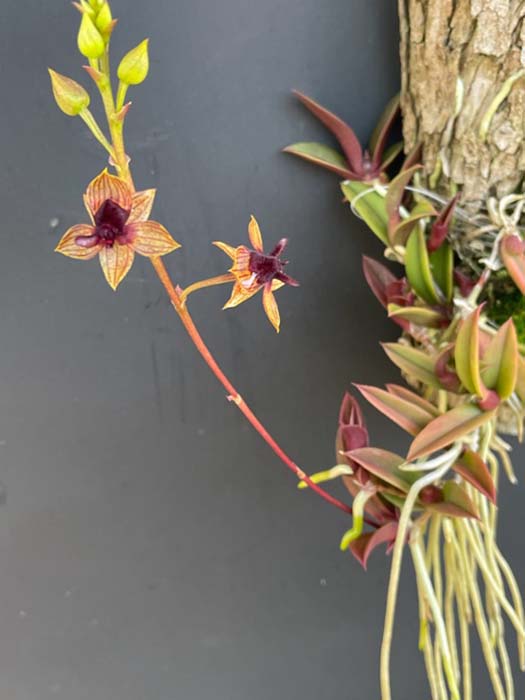 |
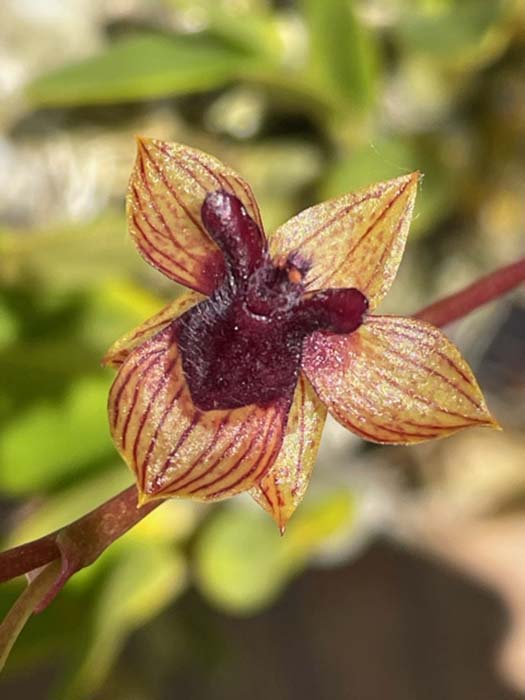 |
Trichoceros muralisNative to Ecuador at elevations of 2200-3200m. Kew lists this as an epiphyte, but orchidspecies.com has it as a terrestrial species. I am growing it mounted with bright light. |
|
From Chris Ehrler:
|
|
California Central Coast |
|
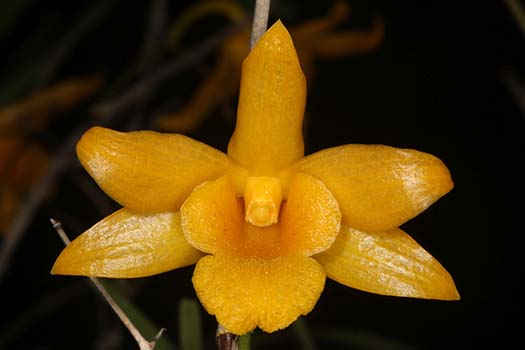 Dendrobium hancockiiA hot to cool growing epiphytic found at an elevation of 200 to 1600 meters in southern China on tree trunks. This orchid is growing in a clay pot filled with bark and lava rock. Currently growing in a cool greenhouse but has grown well outside in past years. |
|

Dendrobium trantuaniiIn orchidspecies.com this is reported to be a warm growing epiphyte native to in northwestern Vietnam elevations of 800 to 1000 meters. But this orchid is growing well mounted on a piece of cork bark which is in a cool greenhouse. It has survived 40 F nights in winter. |
 |
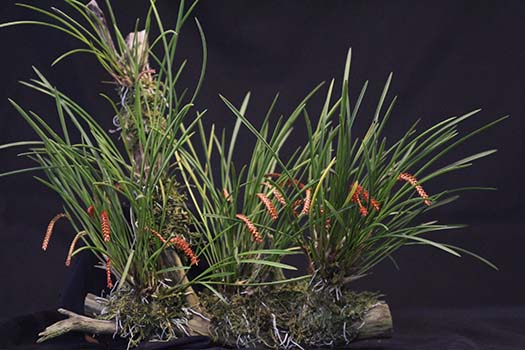
Dendrochilum wenzeliiA hot to warm growing epiphytic species frond in the Philippines at elevations of 300 to 1,000 meters. This orchid is growing well mounted and hanging in a cool greenhouse, but maybe would grow and flower better in a warmer environment. |
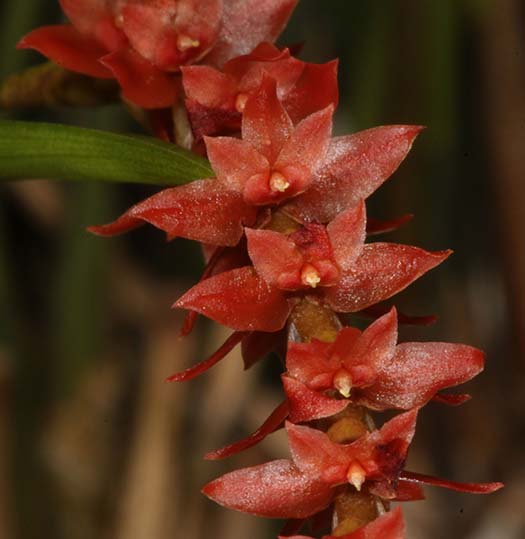 |
 citrina lip closeup sfs.jpg) |
|
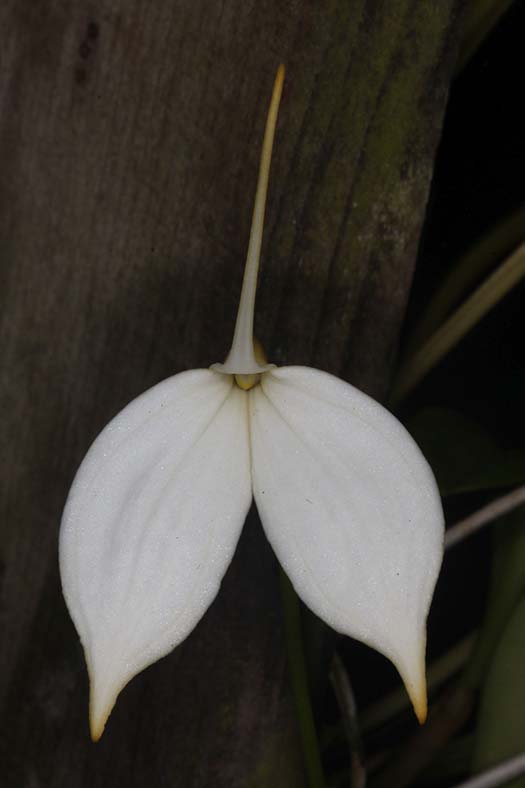
Masdevallia coccinea 'Blanca' f. alba
|
|
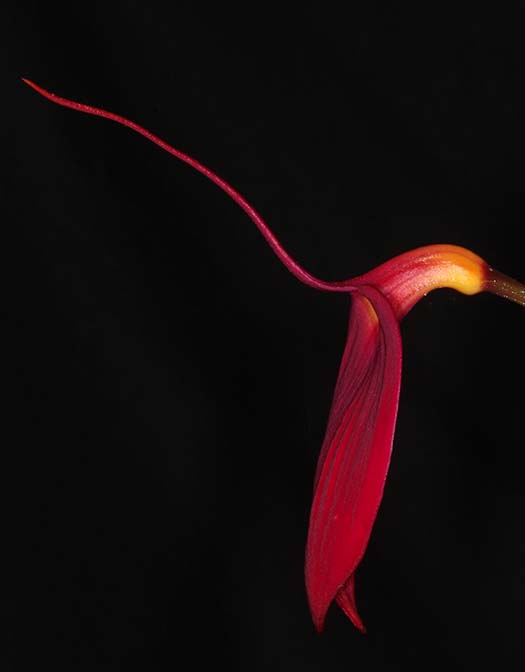
Masdevallia coccinea 'San Bars Red Flaire'There are many color forms of this species. This cold growing species is native to Colombia at elevations of 2,400 to 3,000 meters. This plant is growing well both mounted and in a clay pot filled with a mixture of bark and lava rock with both placed on the north side of the house where they get diffuse light and generally stay cool. |
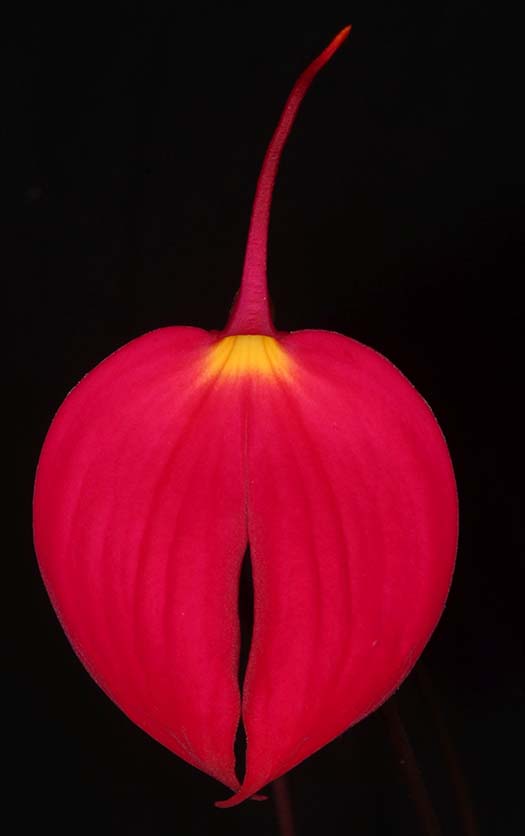 |
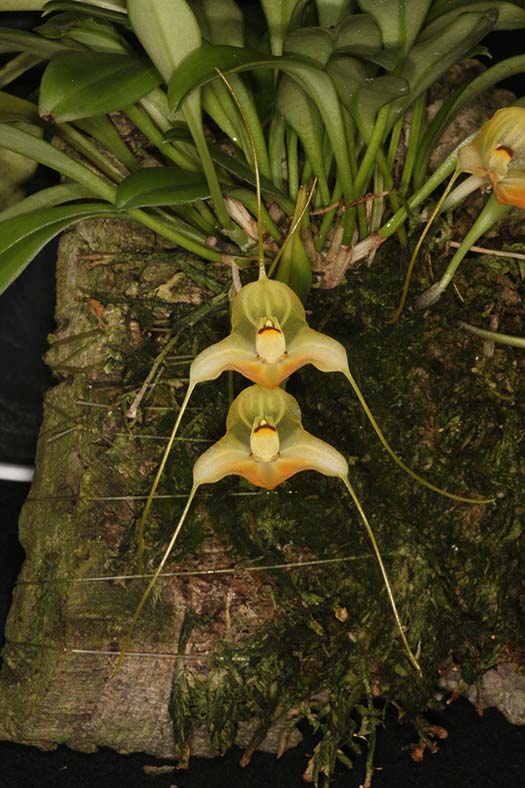 Masdevallia santae-insesaeA cool to cold growing epiphyte found in southern Ecuador in cloud forests at an elevation of 1900 to 2500 meters. Growing in a cool greenhouse mounted on a piece of cork oak with some sphagnum moss on the roots. |
|
 |
|
 |
|
Pleurothallis canaligeraIs native to Colombia, Ecuador and Peru growing in cool or cold environment as either an epiphyte or as a terrestrial. Growing in a cool greenhouse in a plastic pot filled with bark and lava rock. |
|
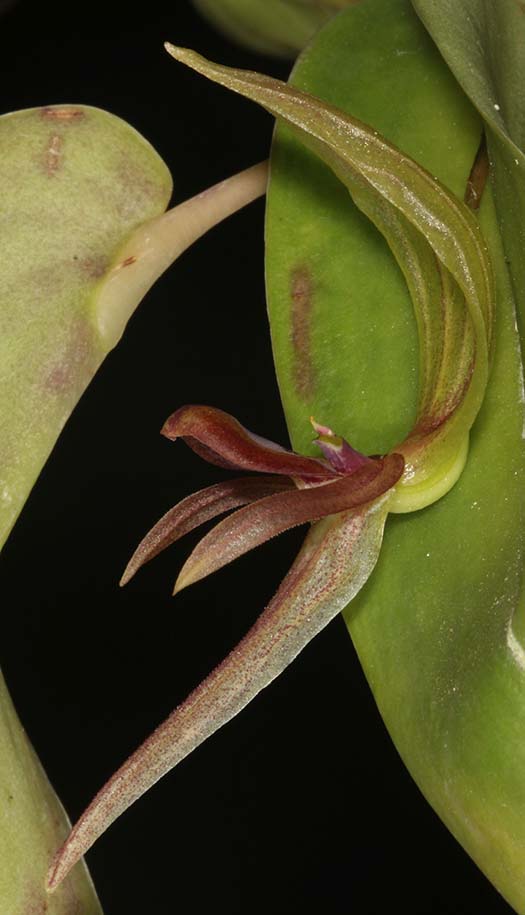
Pleurothallis grandiflora 'Gigi'A cool to cold growing epiphyte found natively in Venezuela, Colombia, Ecuador, Peru, and Bolivia at elevations of 1100 to 3300 meters. This orchid is in a cool greenhouse and is growing in a clay pot filled with sphagnum moss. |
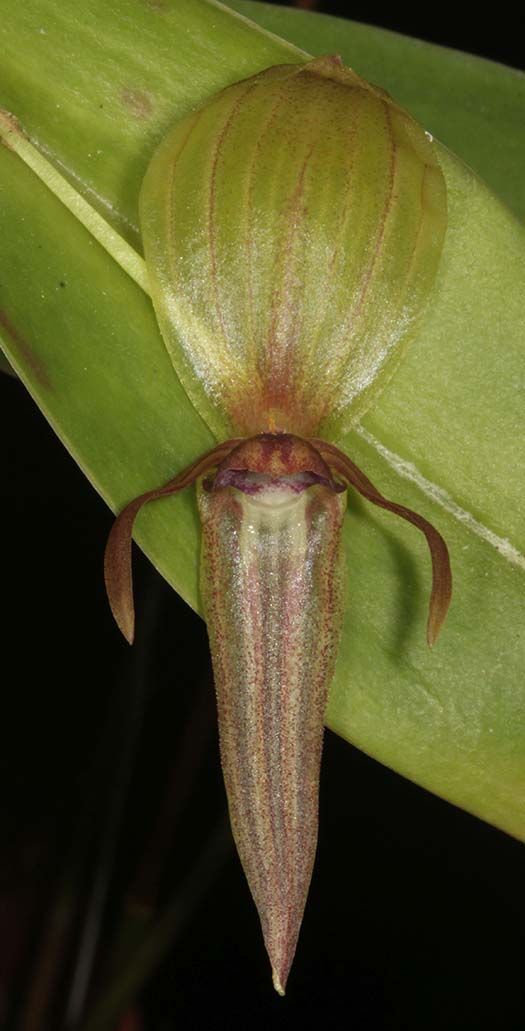 |

Pleurothallis linguiferaFound at elevations of 1,500 to 3,400 meters as a cold to cool growing epiphyte in Colombia, Ecuador, Peru, Bolivia, and Venezuela. This orchid is growing in a clay pot filled with sphagnum moss, with the pot in a cool greenhouse. |
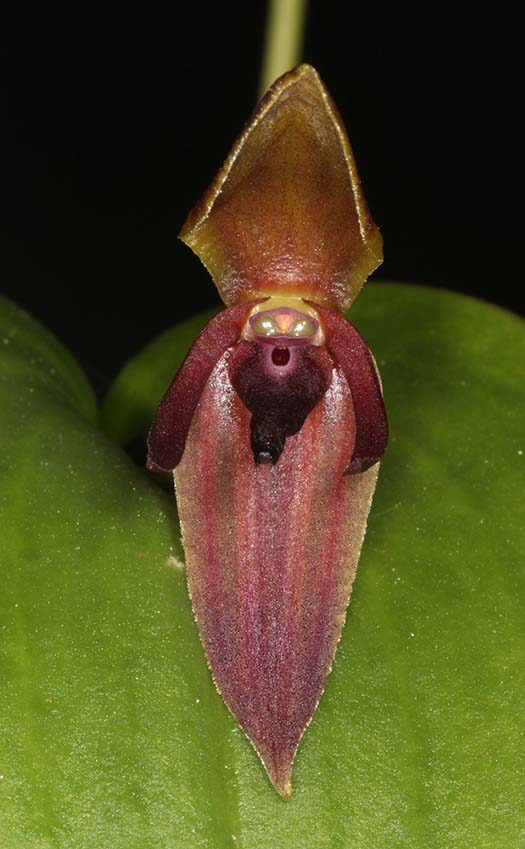 |
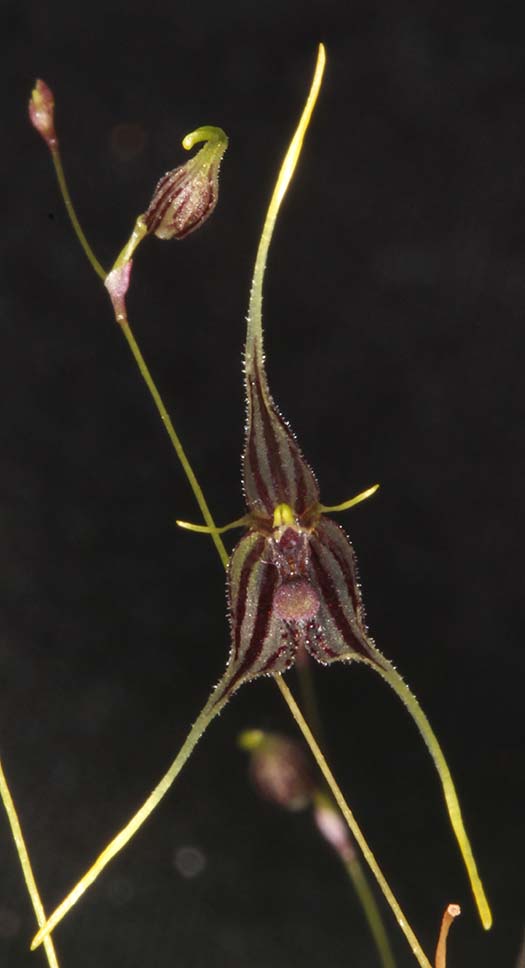
Pleurothallis macroblepharisA cool to cold growing epiphytic species found in Colombia, Carchi, Imbabura, Ecuador, and Peru at elevations of 1,600 to 2,350 meters. Growing mounted with some sphagnum moss on the roots hanging in a cool greenhouse. |
 |
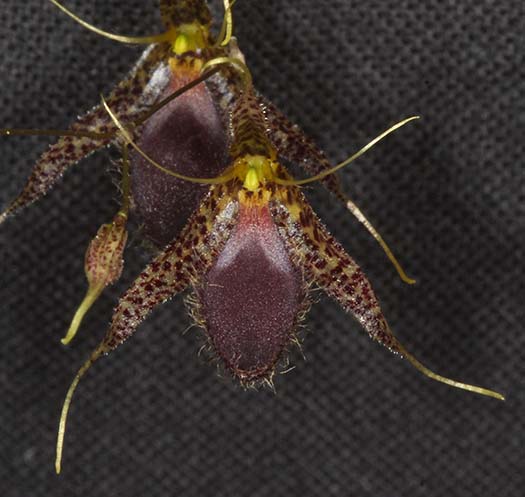
Pleurothallis meagalopsA cool to cold growing epiphytic species growing on the western slopes of the Andes in Ecuador at elevations around 1600 meters. Growing mounted with some sphagnum moss on the roots hanging in a cool greenhouse. |
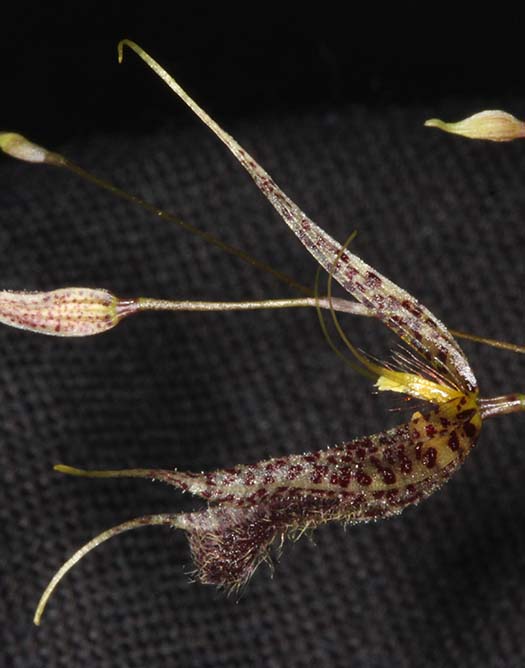 |
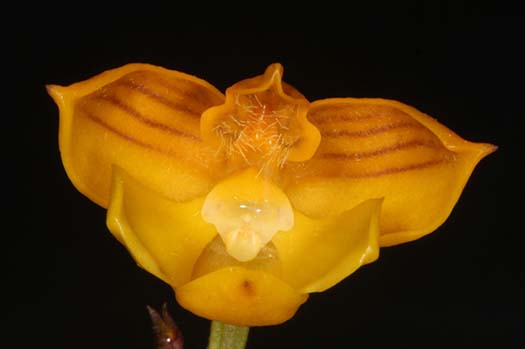
Polystachya pubescensThis cool to cold growing species is found in Eswatini (formerly Swaziland in South Africa) grows both as an epiphyte or lithophyte as a cool to cold growing species at elevations up to 1500 meters. Currently growing mounted with the mount hanging outside under a wood lath.
|
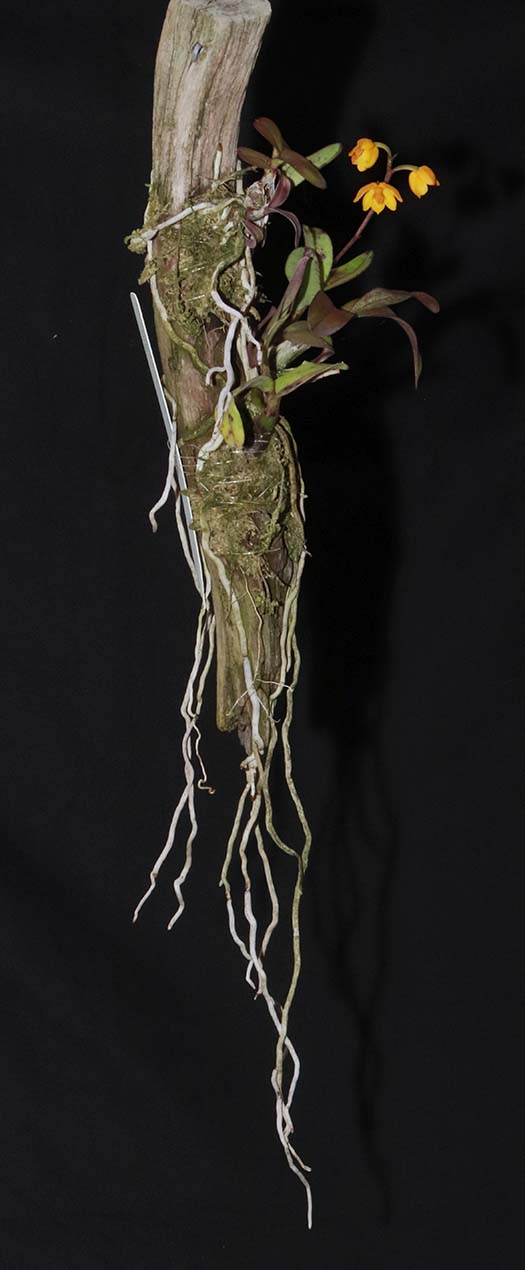 |
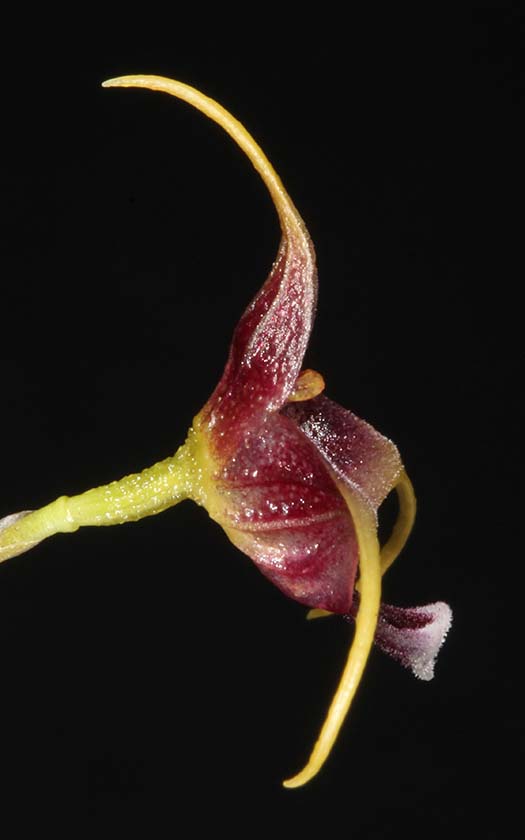 |
|
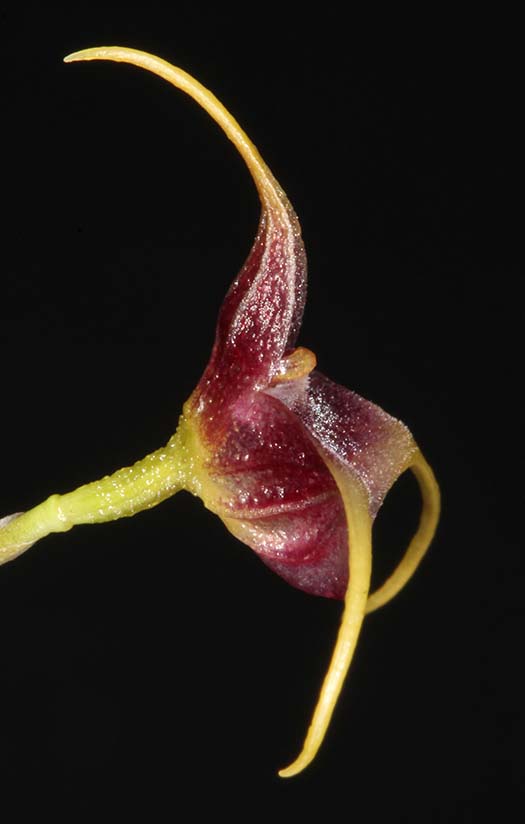 |
|
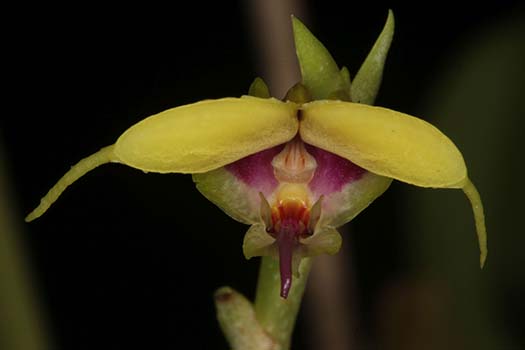
Scaphosepalum grandeA cool growing epiphytic species growing at elevations of 1,200 to 1,500 meters in Colombia. This orchid is growing in a mesh pot filled with a mixture of bark and lava rock. |
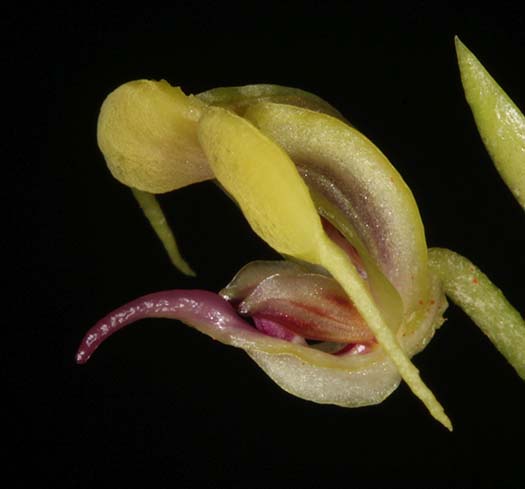 |
 |
Phalaenopsis (Sedirea) japonicaThis fragrant orchid grows in Japan, the Ryukyu Islands, Korea and western Yunnan and Zhejiang provinces of China at elevations of 600 to 1400 meters as a cool to cold growing species. This orchid is growing mounted in a cool greenhouse.
|
From Arnold Markman:
|
|
Intermediate Greenhouse, coastal San Diego area
|
|
Bulbophyllum wendlandium |
|
Bulbophyllum thaiorum |
|
 |
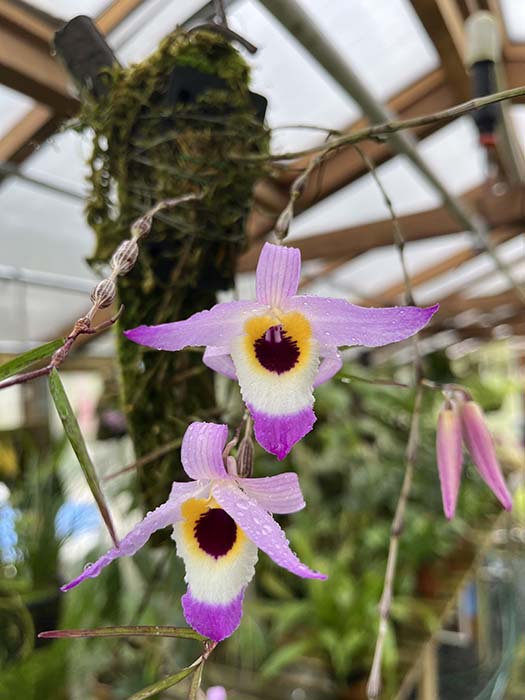 |
Cymbidium tigrinumGrown mounte. Watered every 2-3 days in winter, daily rest of the year, |
Dendrobium falconeriNot watered from mid-November to mid-February, but misted daily. (Ed.: Misting is watering...) Gets full watering after mid-February. |
Dendrobium ceraula (gonzalesii)A couple of the canes have nothing on them, they looked dead. This plant sprouts flowers from the deadest looking canes |
|
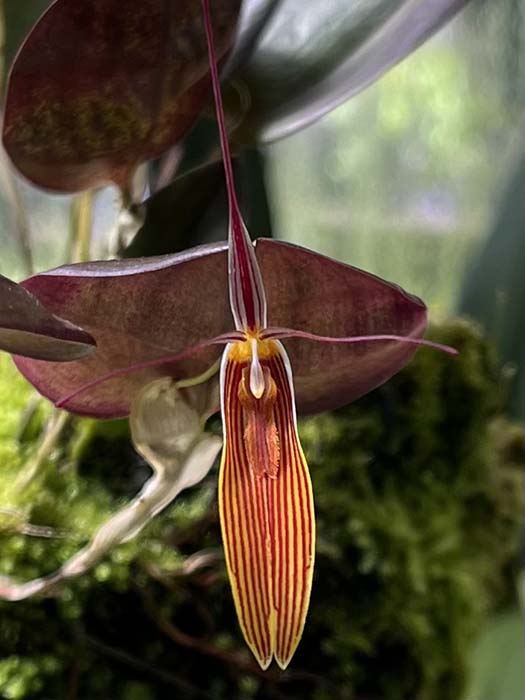 Restrepia brachypus |
|
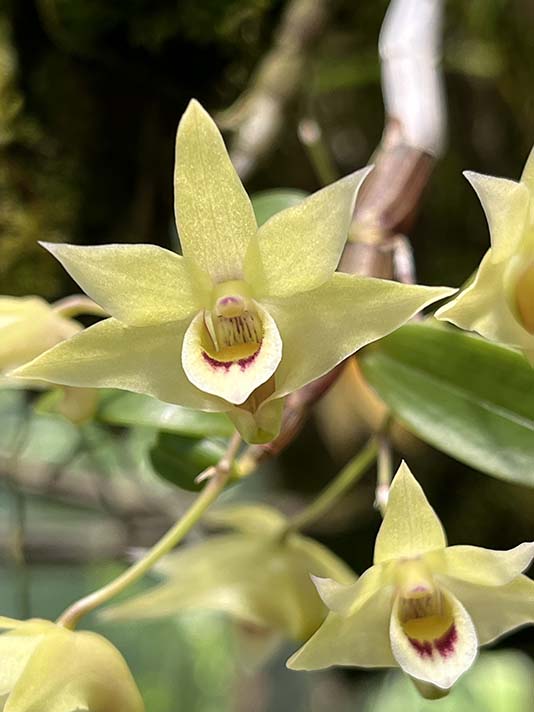 |
|
Dendrobium stricklandiumNot heavilly watered from mid-November to mid-February, but misted daily. Gets full watering after mid-February. |
|
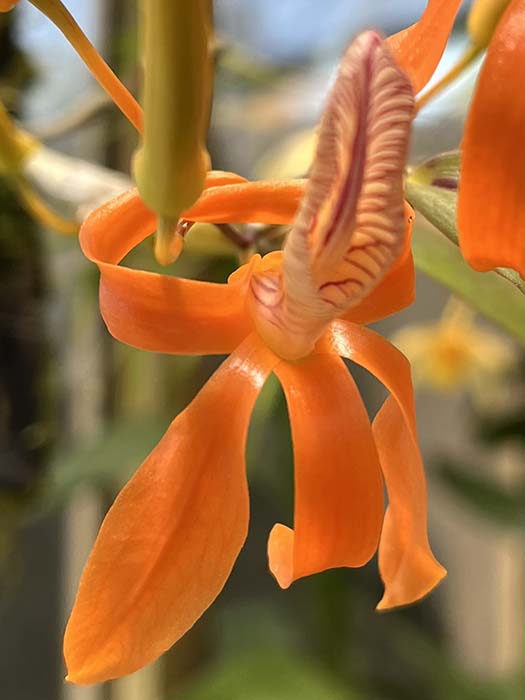 |
|
Dendrobium unicumNot heavilly watered from mid-November to mid-February, but misted daily. Gets full watering after mid-February. |
|
 Dracula villegasiiThis grows in the cooler and windier east end of intermediate greenhouse. |
 |
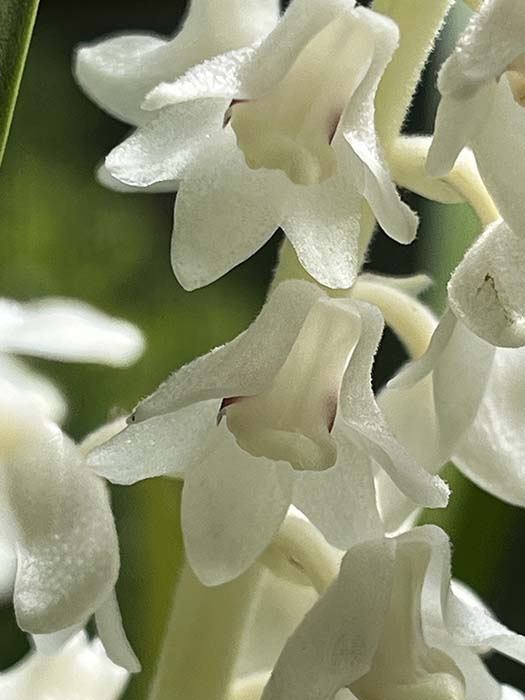 |
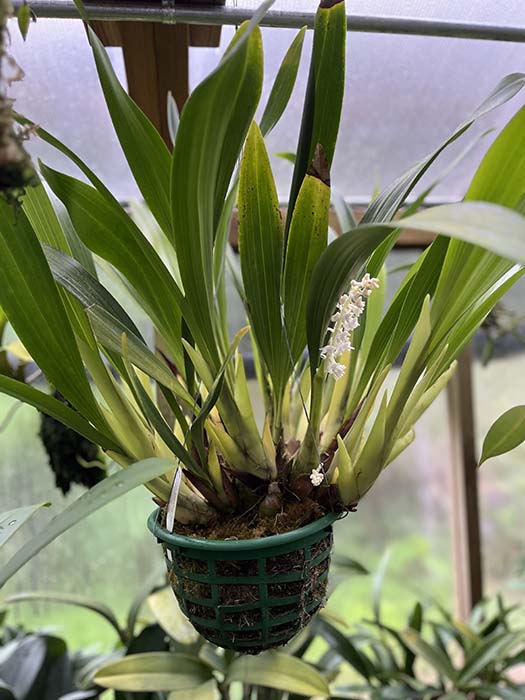 |
Eria sp.
|
|
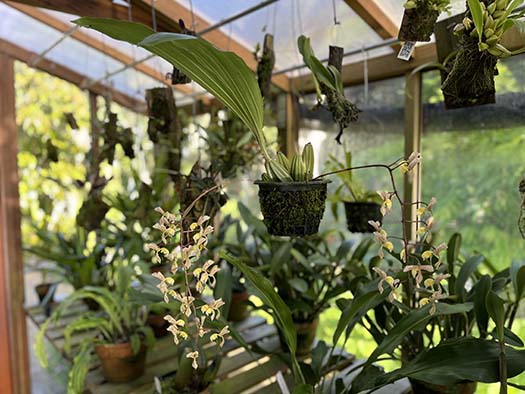
Gongora scaphephorusThis bloomed in February (shown in March) and bloomed again in May. |
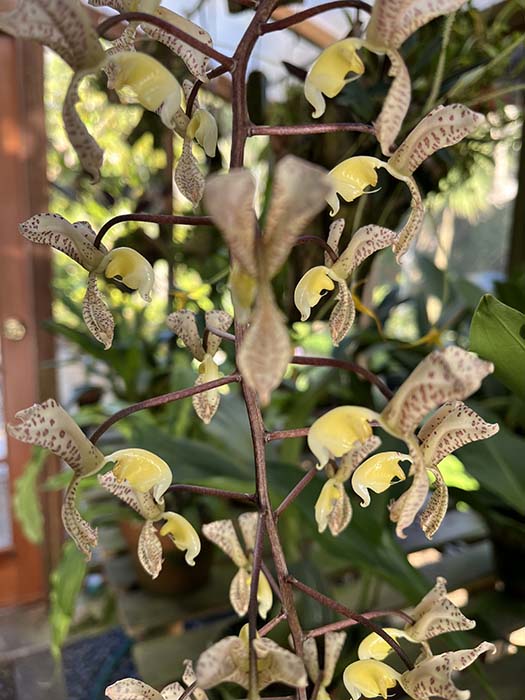 |
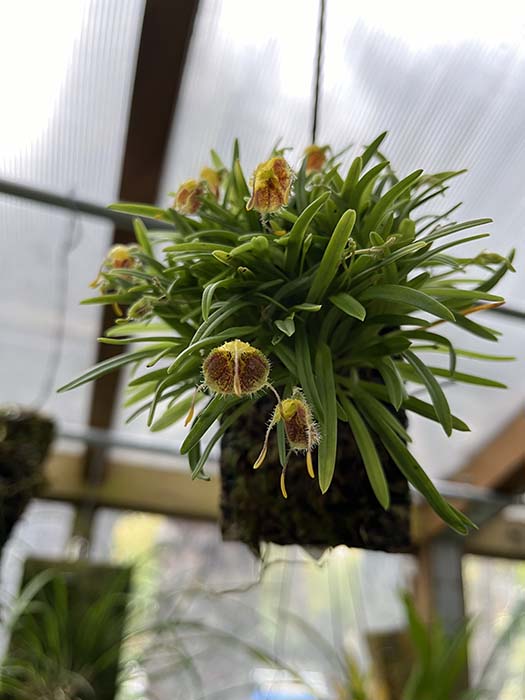 |
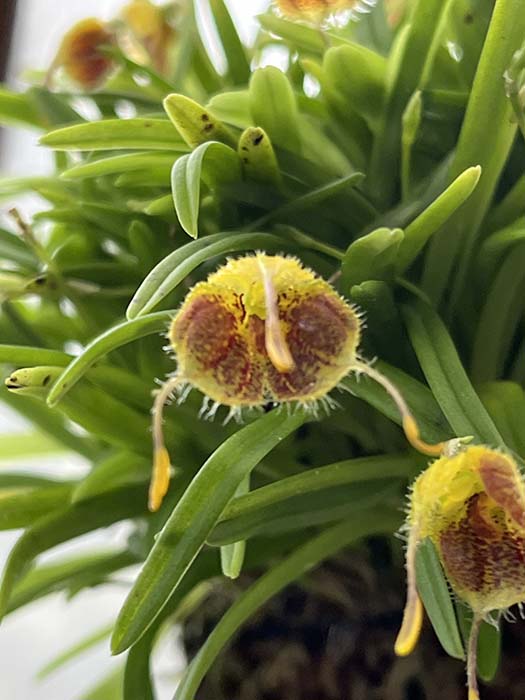 |
Masdevallia erinacea |
|
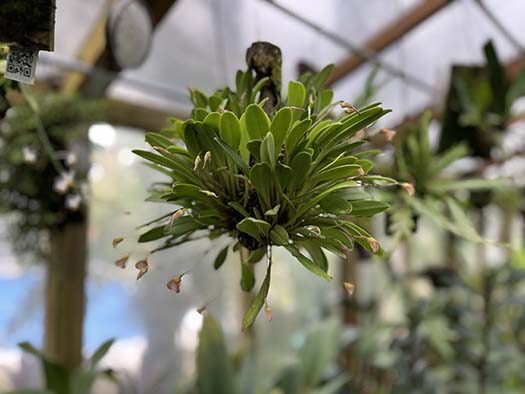 |
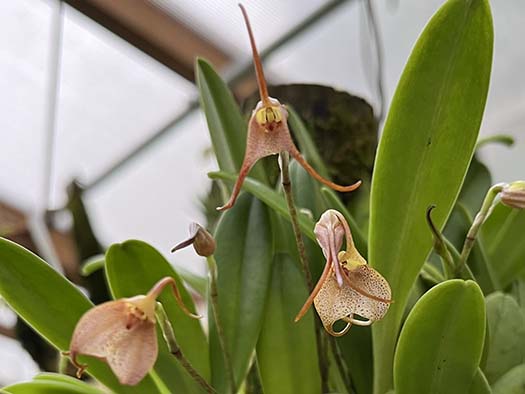 |
Masdevallia floribundaOne can see why it is named floribunda! |
|
 Schoenorchis juncifolia |
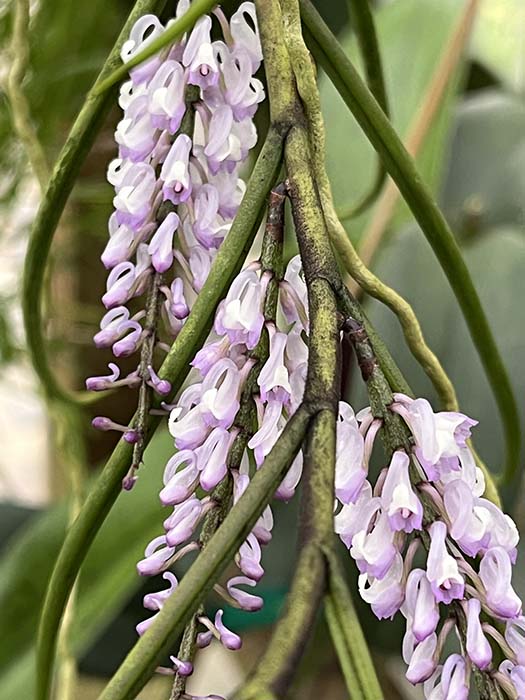 |
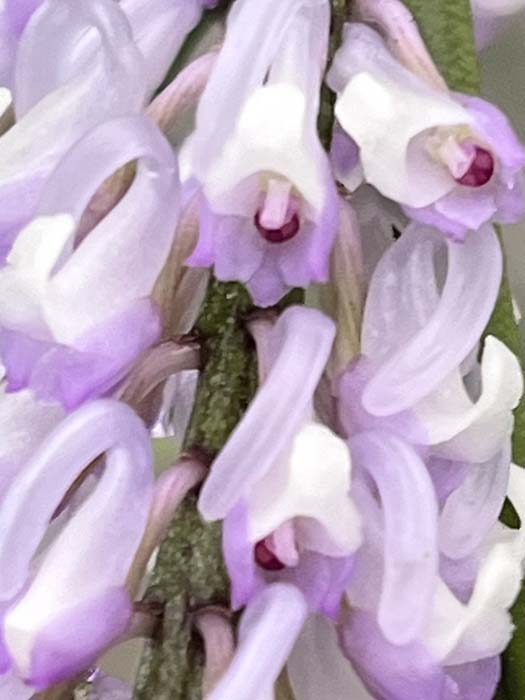 |
|
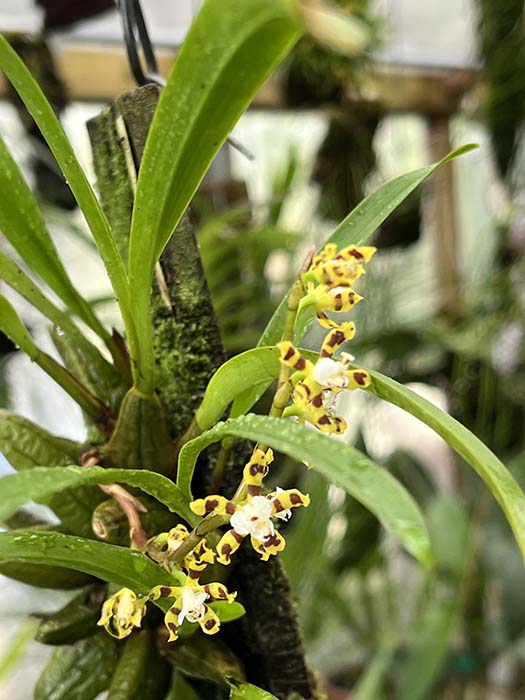 |
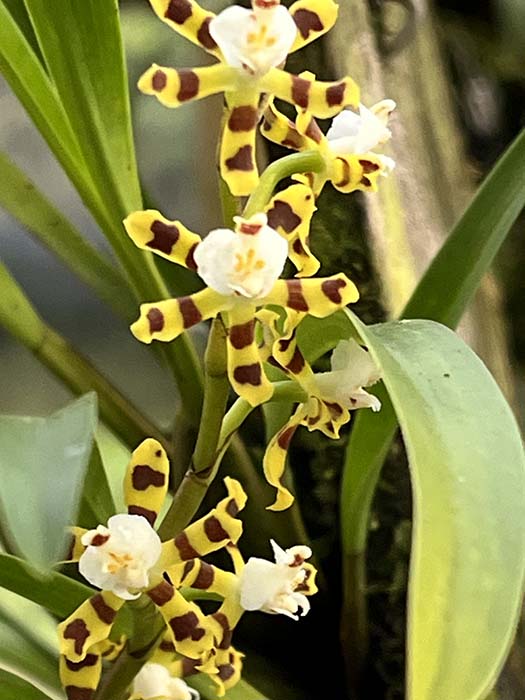 |
Oncidium (Solendiopsis) tigroides |
|
From Scott McGregor:All orchids grown outdoors, coastal southern California |
|

Sobralia rupicolaA recent acquisition of a large plant so I can’t take credit for the flowers this year, but an awesome compact Sobralia species from Bolivia, growing up to 1900 meters. The 3” flowers last a week or so (that’s long for a Sobralia) and have multiple buds on lateral nodes near the top, rather than sequentially flowering from the terminal node like most Sobralias. The flowers remind me of S. callosa, as they are in the same subsection Abbreviatae. I had previously purchased a seedling of this rare species from Andy Phillips a couple years ago and it is probably a year or two from blooming—open to sell/trade that one if anyone is interested.
|
|
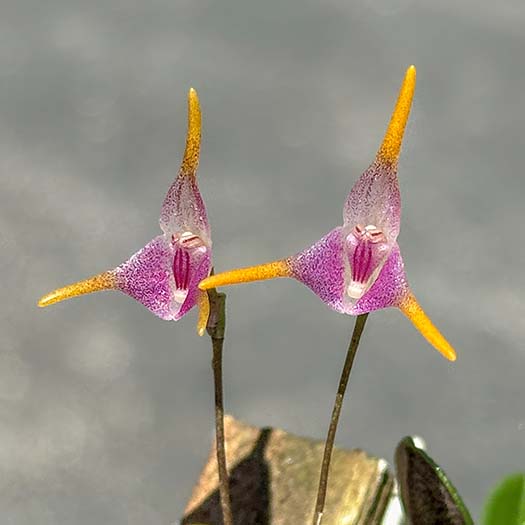
Porroglossum meridionaleA happy Porroglossum just coming into bloom with small but cute flowers. This species is one of the easier outdoor Porro’s. |
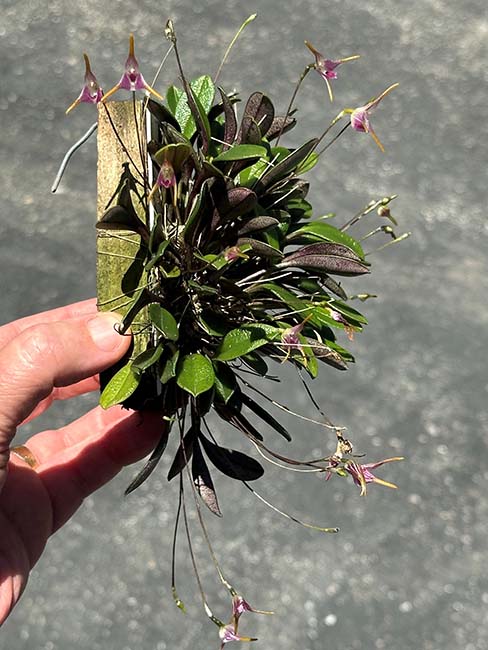 |
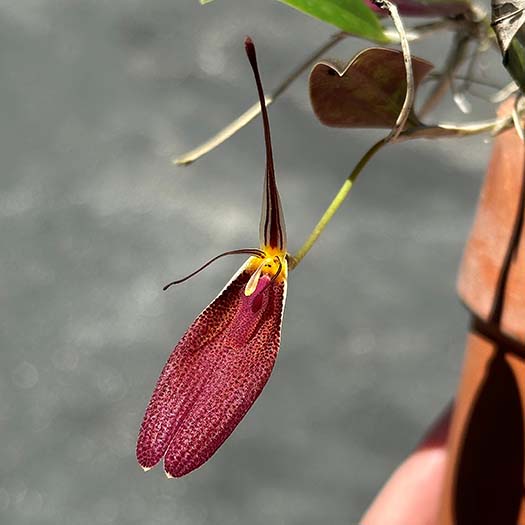
Restrepia sanguineaBlood-red Restrepia, with original tag. They sure don’t make plastic tags like they used to—this one has bloom records back 34 years! |
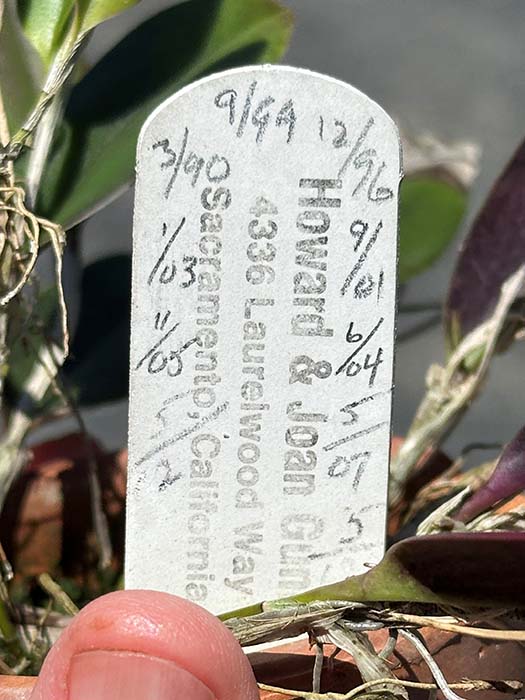 |
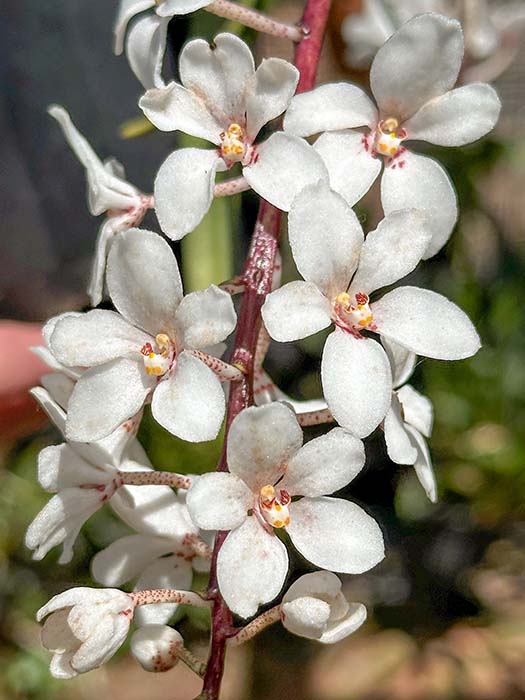 |
 |
Sarcochilus hartmanniiA reliable and cheerful Spring bloomer |
|
From Roberta Fox:Coastal southern California |
|
Outside in the Back Yard: |
|
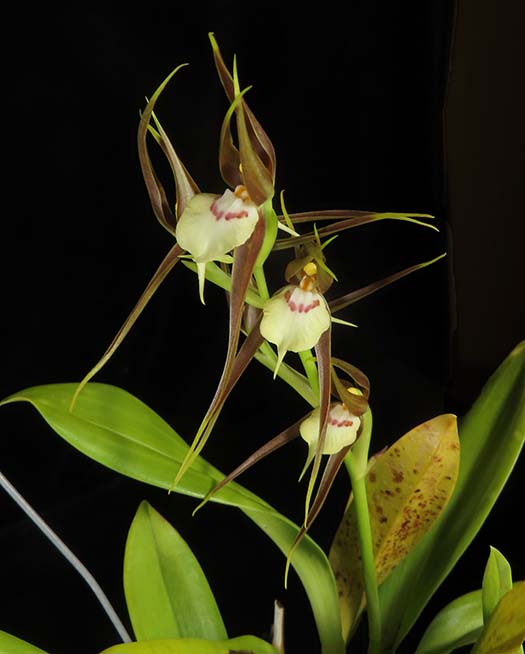
Brassia (Ada) glumaceaNot spectacular, but extremely fragrant, reminiscent of ripe peaches. Often, I smell it before I see it. |
|
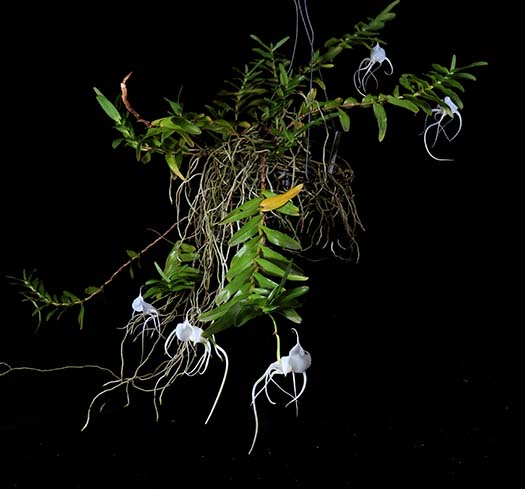
Angraecum germinyanumThe highest number of flowers that I have had open simultaneously. The plant is a rambler - only a small portion of it is still in the basket. Each growth produces one or two flowers at a time, so to get this lovely show, it had to mature with multiple growths. Well worth the real estate that it takes up! |
|
 |
|
Barbosella cucullataThis is a little flower machine. Because the buds are green like the foliage, they are not obvious until they burst into bloom. (Note the top of the plant tag in the background, for scale.) Native to Ecuador, Bolivia, Colombia, Peru and Venezuela, at elevations from 2500-2900 m. |
|
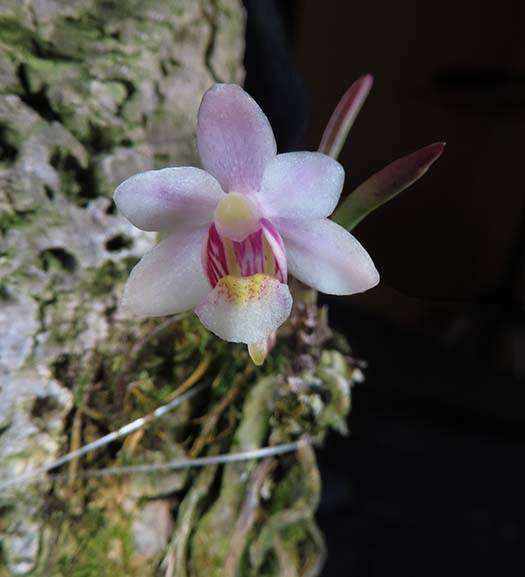
Holcoglossum flavescensSmall flower on an even smaller plant. Native to southwest and south central China, elevation 1200-2000 m. |
|
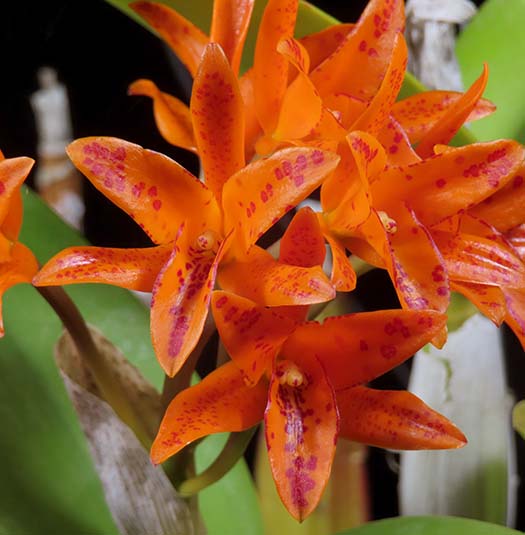 Guarianthe (Cattleya) aurantiacaThis species grows in Mexico and Central America at a range of elevations, 300-1100 m. Flowers have heavy, waxy substance. Clear orange is the most common color, then there are heavily-spotted ones, and also lemon-yellow. |
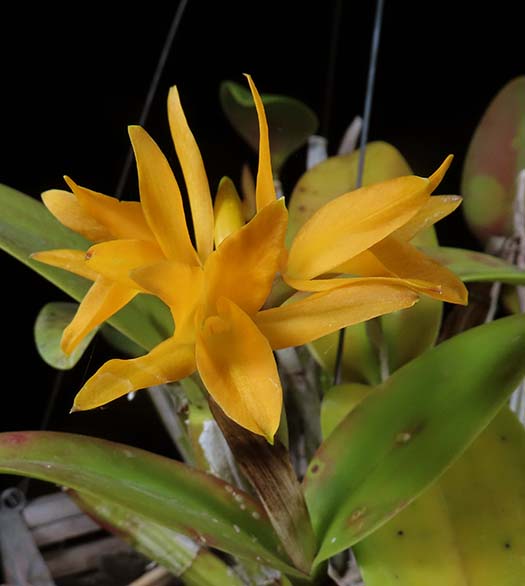 |
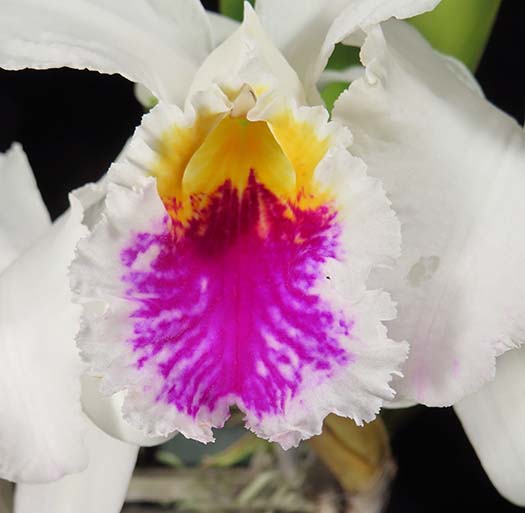 |
|
Cattleya mossiae f. semi-albaThis is the national flower of Venezuela, growing at elevations from 900-1500 m. Locally know as "Flor de Mayo", for its bloom time. It is sweetly fragrant. The typical form is lavender. (I have one of those also, but the thrips got to it first, alas.) |
|
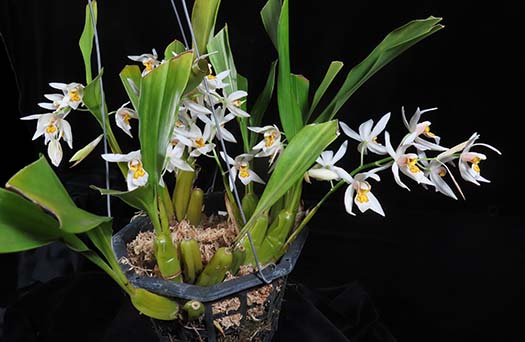 Coelogyne nitida (Coelogyne ochracea)Kew considers these to be synonyms. At the last meeting of the San Diego County Orchid Society Species Study Group, several people disagreed with the synonymy, considered it to be Coel. ochracea. Either way, it's native to the Himalaya region of northern India, China SW, and much of Southeast Asia, at elevations 1500-2300 m. |
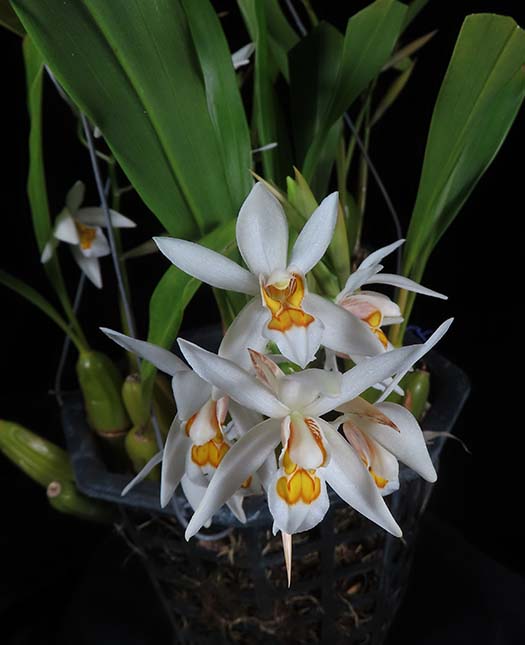 |
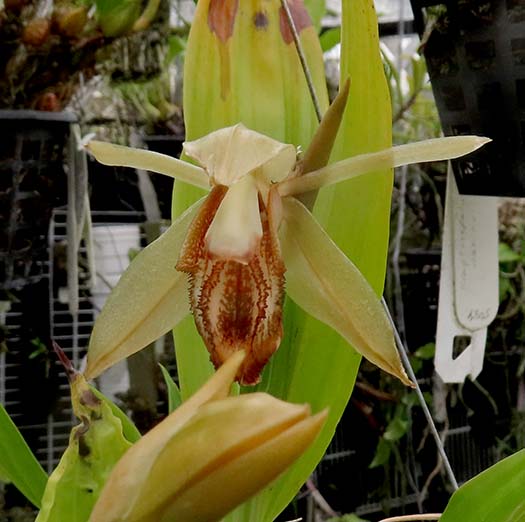
Coelogyne speciosaNative to Java, Sumatra, Borneo at elevations 750-1800 m. produces several flowers sequentially on each inflorescence. |
 |
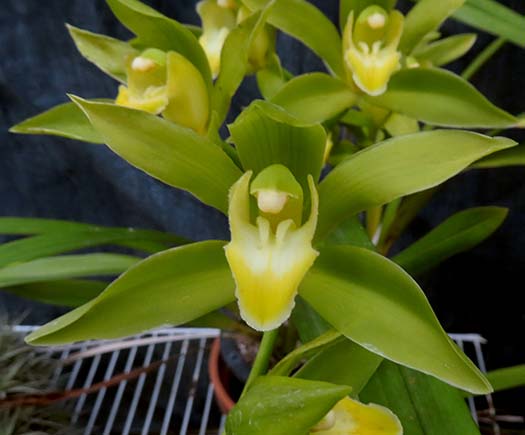
Cymbidium lowianum f. concolorCym. lowianum is very popular as a decorative plant in China and southeast Asia. This plant has been in my collection for a long time, has not bloomed for many years, and suddenly it did. This year has been weird, with some usually-reliable orchids blooming pooly or not all, and others puttiing on a much better-than-usual show. This one clearly liked what Mother Nature threw at it. |
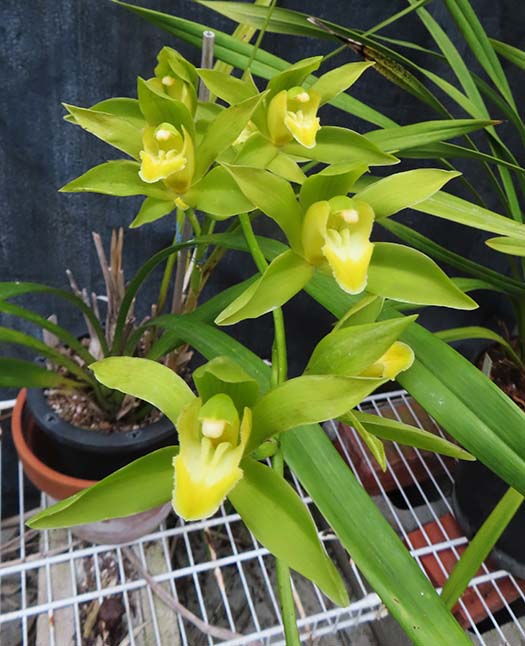 |

Dendrobium jenkinsiiThis is closely related to Dendrobium lindleyi (aggregatum, aggrevatum...), a relatively miniature version. I have found it to be much more relable than its fussy bigger cousin. It doesn't get dried out in winter, and blooms anyway. |
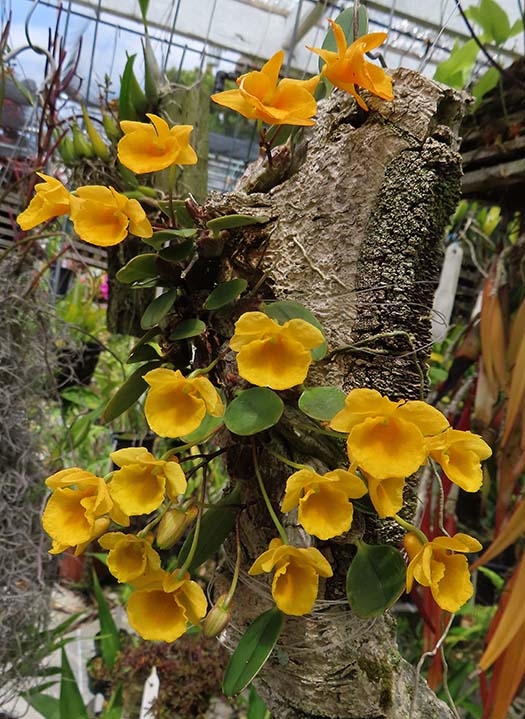 |
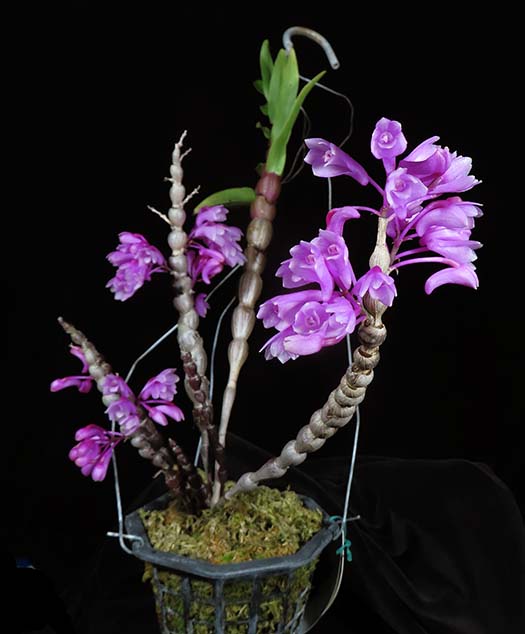
Dendrobium rindjanienseNative to a very limited range of the Lesser Sunda Islands of Indonesia, at around 2000 m. The bumpy canes are fascinating. The bare, leafless canes can re-bloom over several years. As this plant has grown, it went from one little cluster of flowers, to two, and this year just exploded. It is in a 4-inch basket. Very compact, and completely charming. |
 |
|
|
Dendrobium scoriarumNative to Yunnan, China. This one was a total surprise - last year, a bare cane growing from a cluster of bare canes of a completely different species, bloomed with these very distinctive flowers. After the bloom, I repotted it, was able to separate what was, of course, two plants, and potted it separately. The single bare cane is now producing several keikis, and I have high hopes for it. |
|
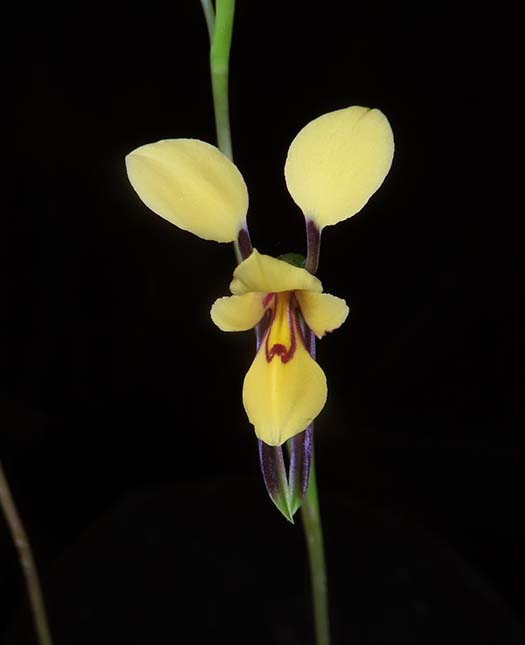
Diuris drummondiiThis is the last of my Mediterranean-climate terrestrials to bloom. The rest have already gone dormant. It is native to western Australia. It is relatively tall, so that it is visible above the grasses with which it grows. |
|
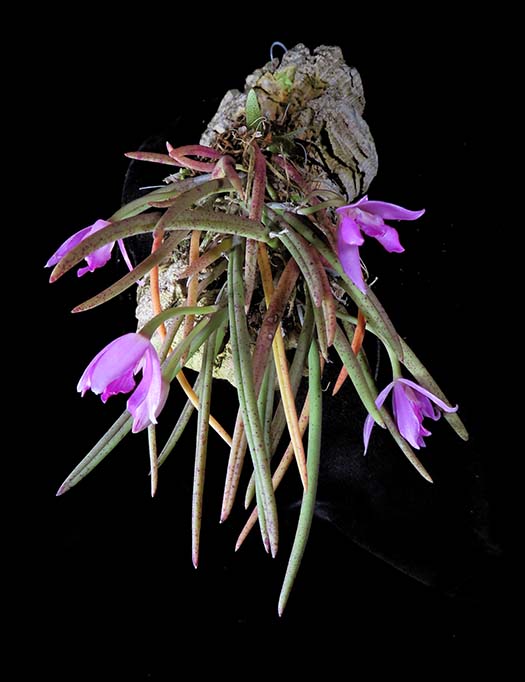
Leptotes pohlitinocoiNative to Brazil, as are my other Leptotes. IOSPE says it is warm-growing, don't tell MY plant! (It does fine in my back yard.) |
 |
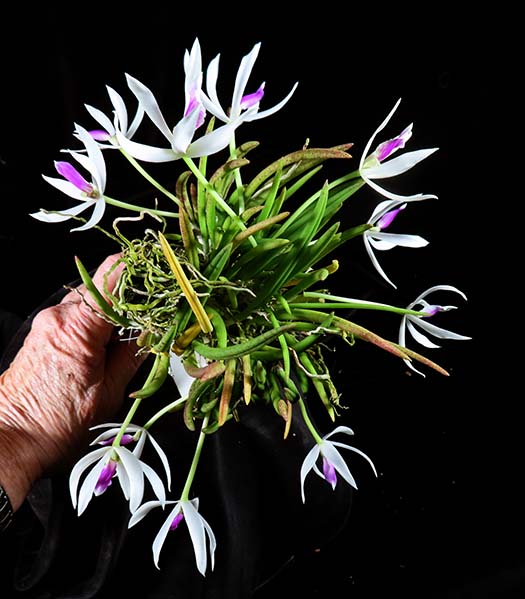
Leptotes bicolorThe largest, and most commonly grown, of the Leptotes species. It easily produces specimen plants. Mine is mounted on a stick which is covered with roots. If it were on a flat mount, with more room to spread out, it likely would have a LOT more flowers. I include it anyway, for comparison with the other species. |
 |

Leptotes unicolorThis species comes in a range of colors, from white to pink to this dark pink. But, as the name implies, one color for any given plant. |
|
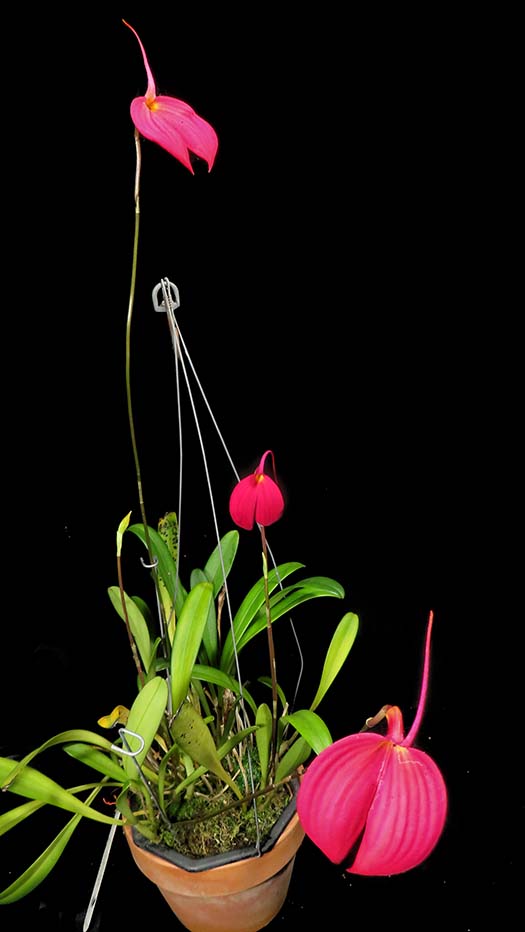 |
|
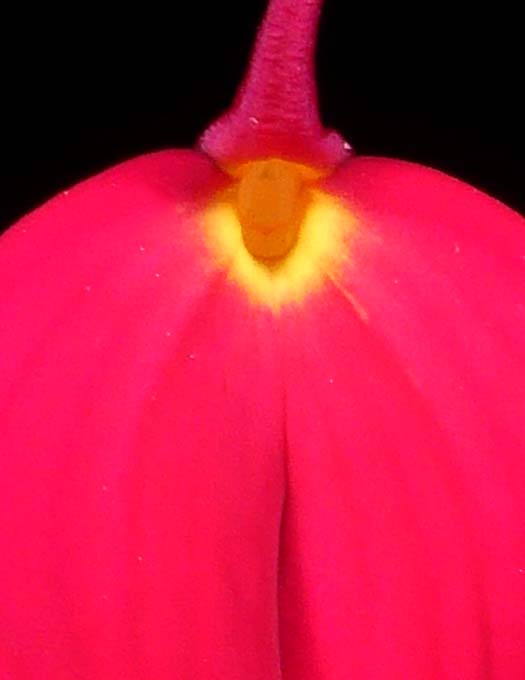 |
|
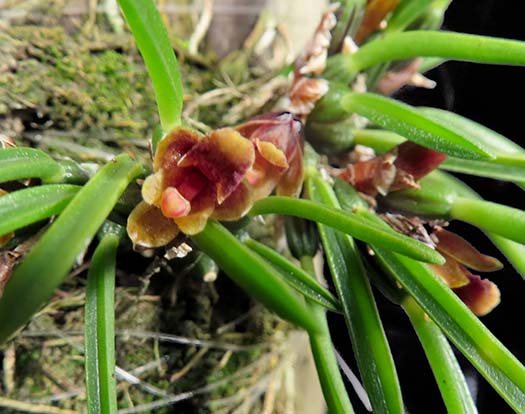
Maxillaria pumila (Maxillaria minuta)Native to SE Brazil, 700-750 m. This is another one that IOSPE says is a warm-grower. but it does fine in my back yard so clearly has cold-tolerance. |
 |
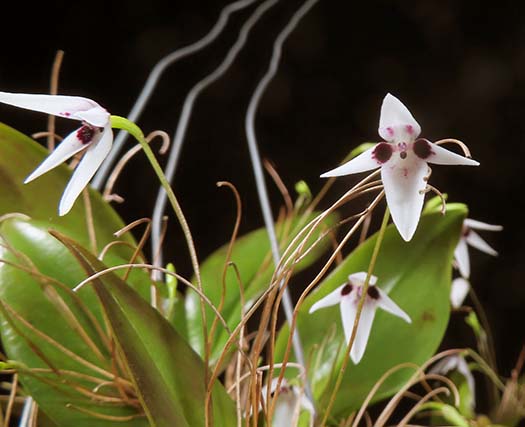 |
 |
Pleurothallis viduataThis is in bloom about 10 months of the year, but in spring it produces its most dense bloom, so now is the time to show it. It produces new flowers sequentially from each growth. I don't trim the old flower stems until the winter when it pretty much stops blooming, since it is very difficult to tell the old ones from the emerging ones. Once a year it gets a haircut. |
|
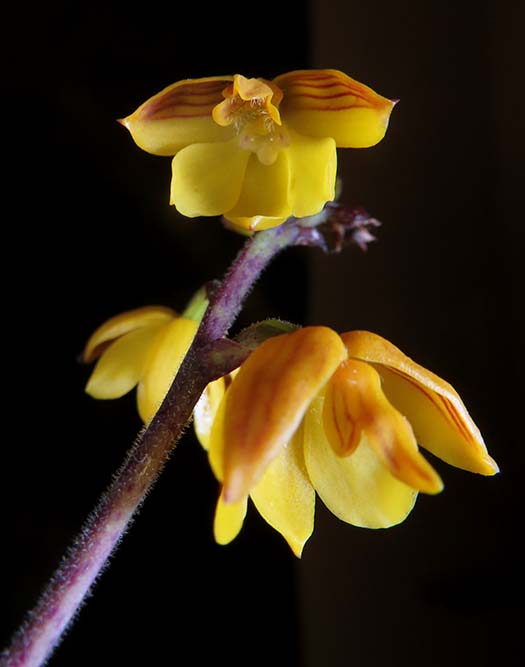 |
|
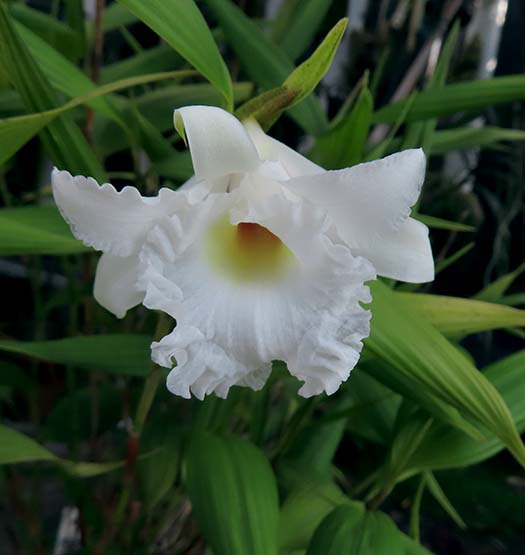 |
|
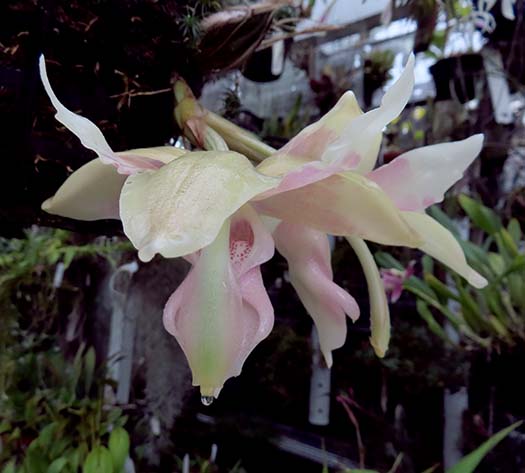
Stanhopea tigrina var. nigroviolacea f. albescensThis species is normally noted for its large, darkly-colored flowers. Here is the albescens form - not alba, it has some faint red pigment (pink, actually), but is very pale, almost ghostly. The photo above was taken just as it was opening. Then, the petals eventually wrap around the sepals. Below, I show the typical form just for reference. Those won't bloom until somewhere around the middle of July, spikes barely starting to be visible. 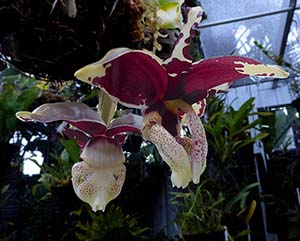 |
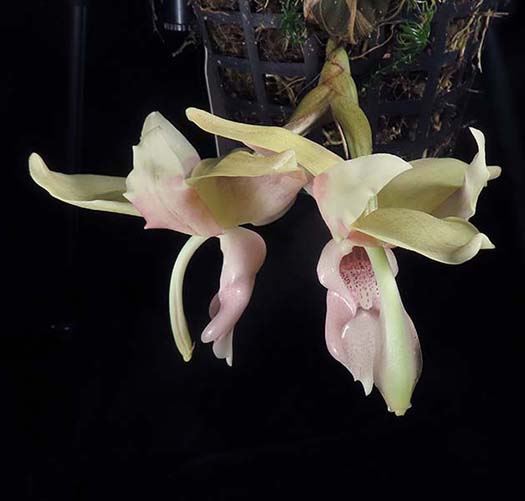 |
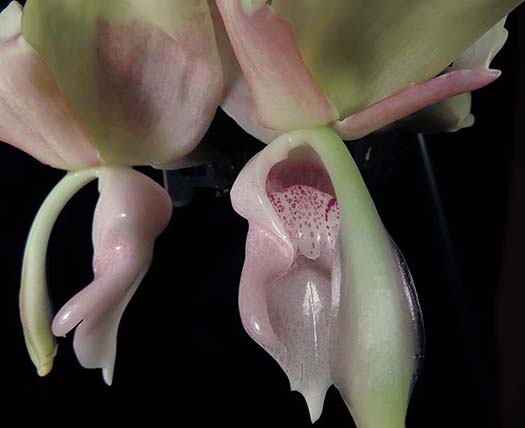 |
|
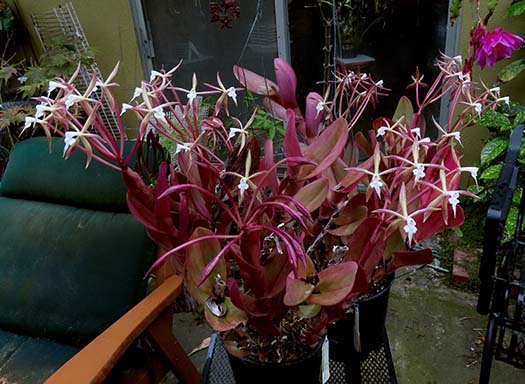
Epidendrum lacustre 'Wow Fireworks' AM/AOSThis is the purple Panama form of the species (the typical form is green and white). Culture is full sun, sopping wet. I hang it up with the L. anceps - anything less than toasing sun and the colors are not as intense. To keep it wet enough in that bright location, it's potted with a big lump of sphagnum in the middle, just filled in with bark. It is extremely vigorous, periodically gets split into two 2-gallon pots so that I can lift the "beast".
|
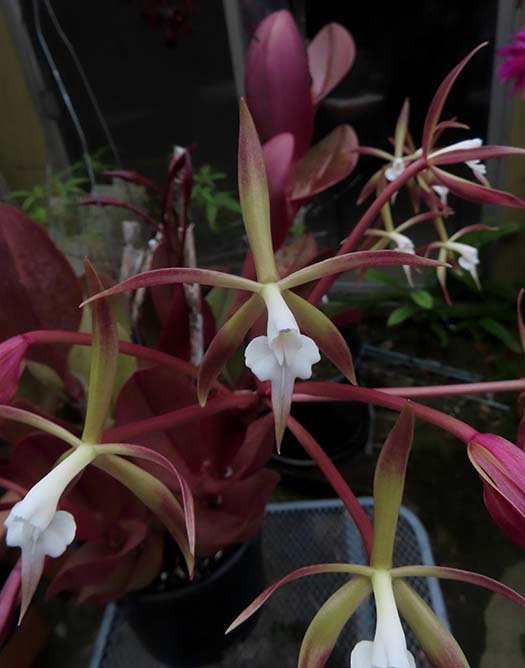 |
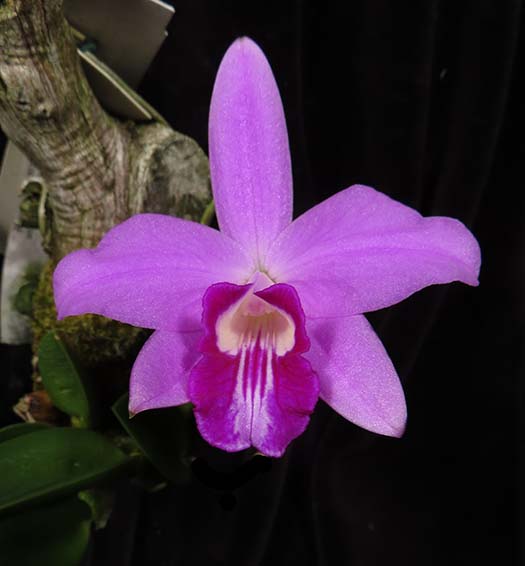
Cattleya (Laelia) sincoranaGreat flower-to-plant ratio. Flower is 3 inches on a 2.5 inch spike. Leaves are around 1.5 inch, pseudobulb about an in inch. Native to Brazil, elevation 1200-1500 m. |
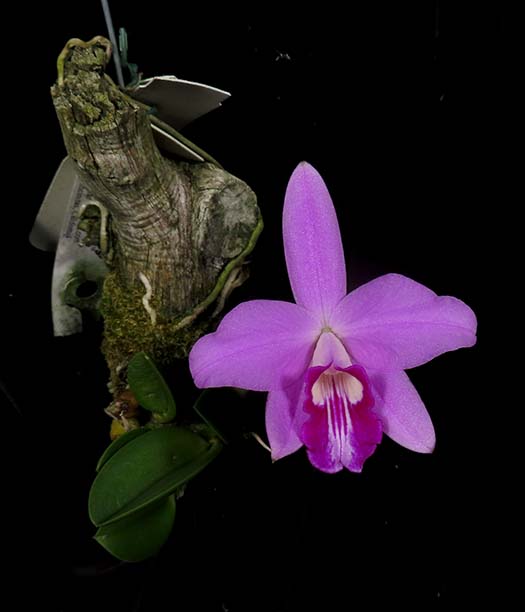 |
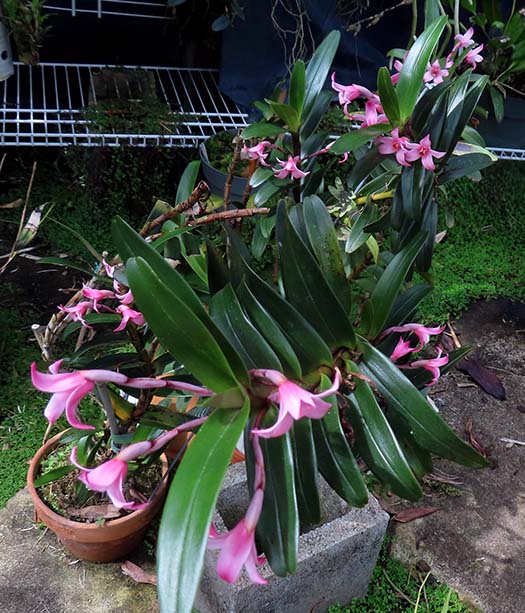 |
|
Arpophyllum giganteumNative to southern Mexico, through Central America to Venezuela. It lives over a wide range of elevations, from 350 m to 2100 m. That would indicate that it could be grown just about anywhere - warm, cool, or whatever. It's growing in a basket wtih very little medium, a very forgiving plant. |
|
In the greenhouse... |
|
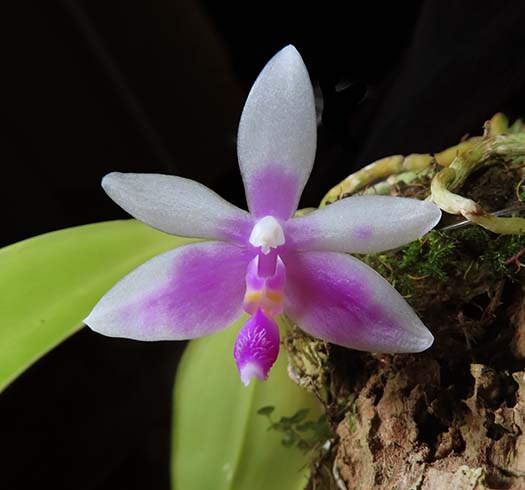
Phalaenopsis modestaFrom Borneo |
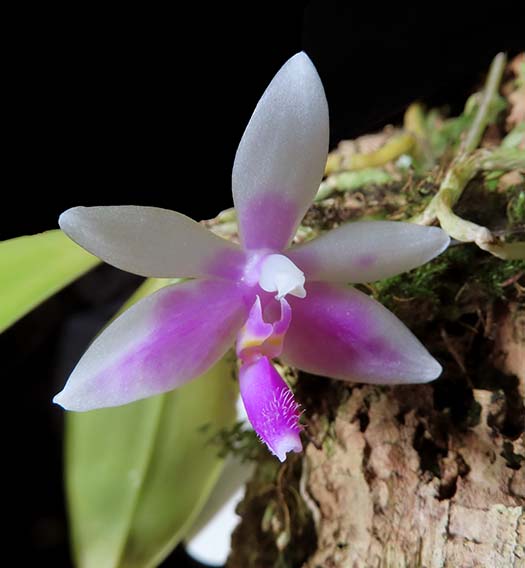 |

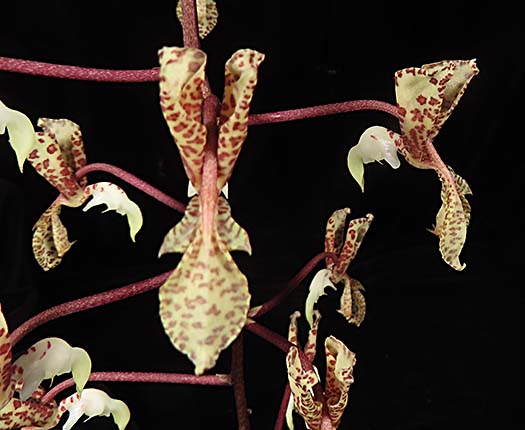
Gongora scaphephorusNative to Colombia, Ecuador, Peru. Bolivia at elevations 600-1100 m. Just a little too warm-growing to be happy outside at my house, I think. From the elevation range, I'd expect a minimum temperature of around 50 deg F would be appropriate. Otherworldly-appearing flowers.
|
 |
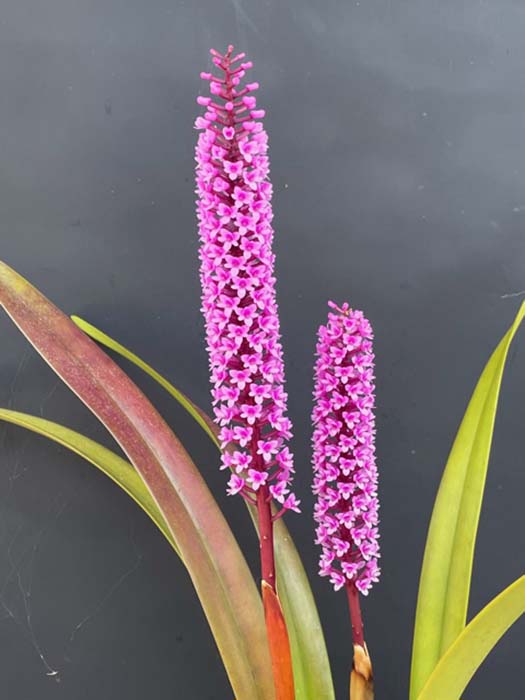

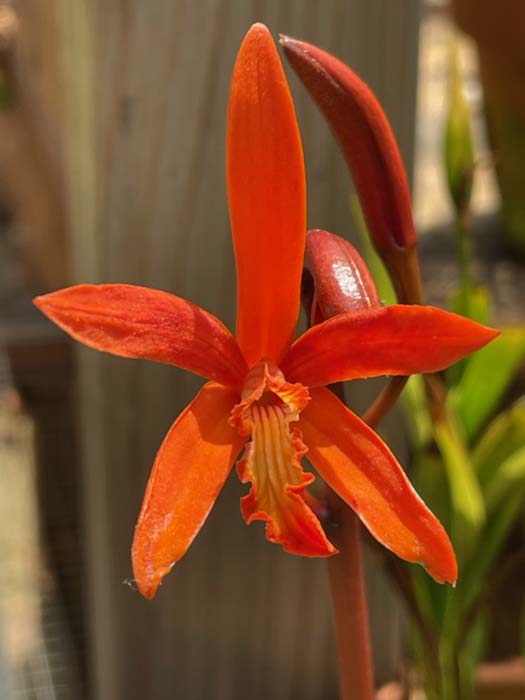

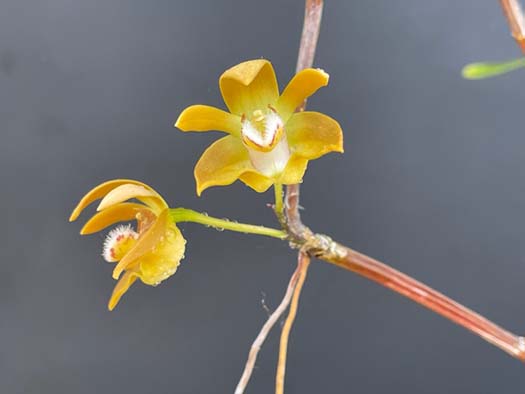


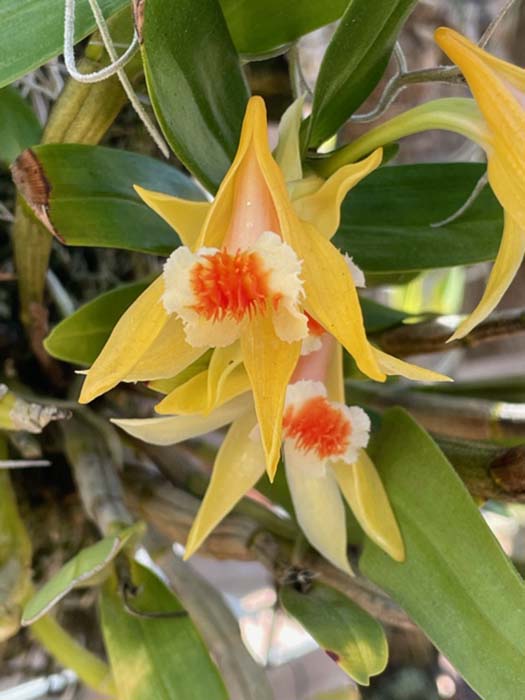
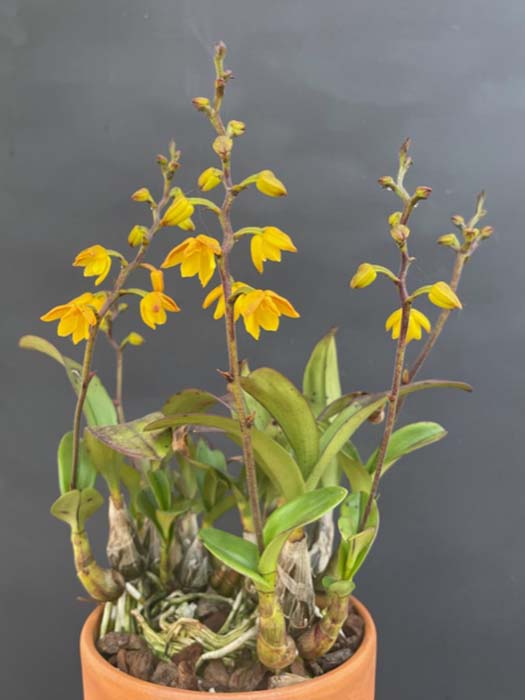

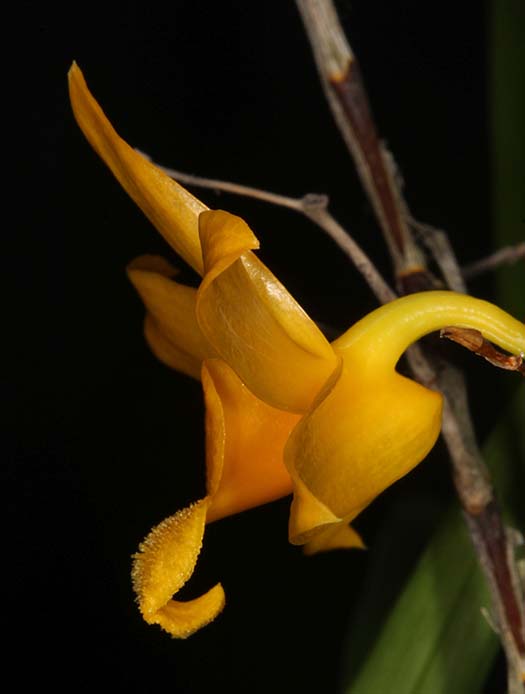
 citrina plant and flower sfs.jpg)
 citrina front cropped.jpg)
